Sport Development Policies and Practices in Australia and International Context
VerifiedAdded on 2023/06/07
|23
|4879
|373
AI Summary
This article discusses the policies and practices used in Australian sports and across the world to facilitate swimming sports development. It also compares swimming sports in Malaysia and Australia.
Contribute Materials
Your contribution can guide someone’s learning journey. Share your
documents today.
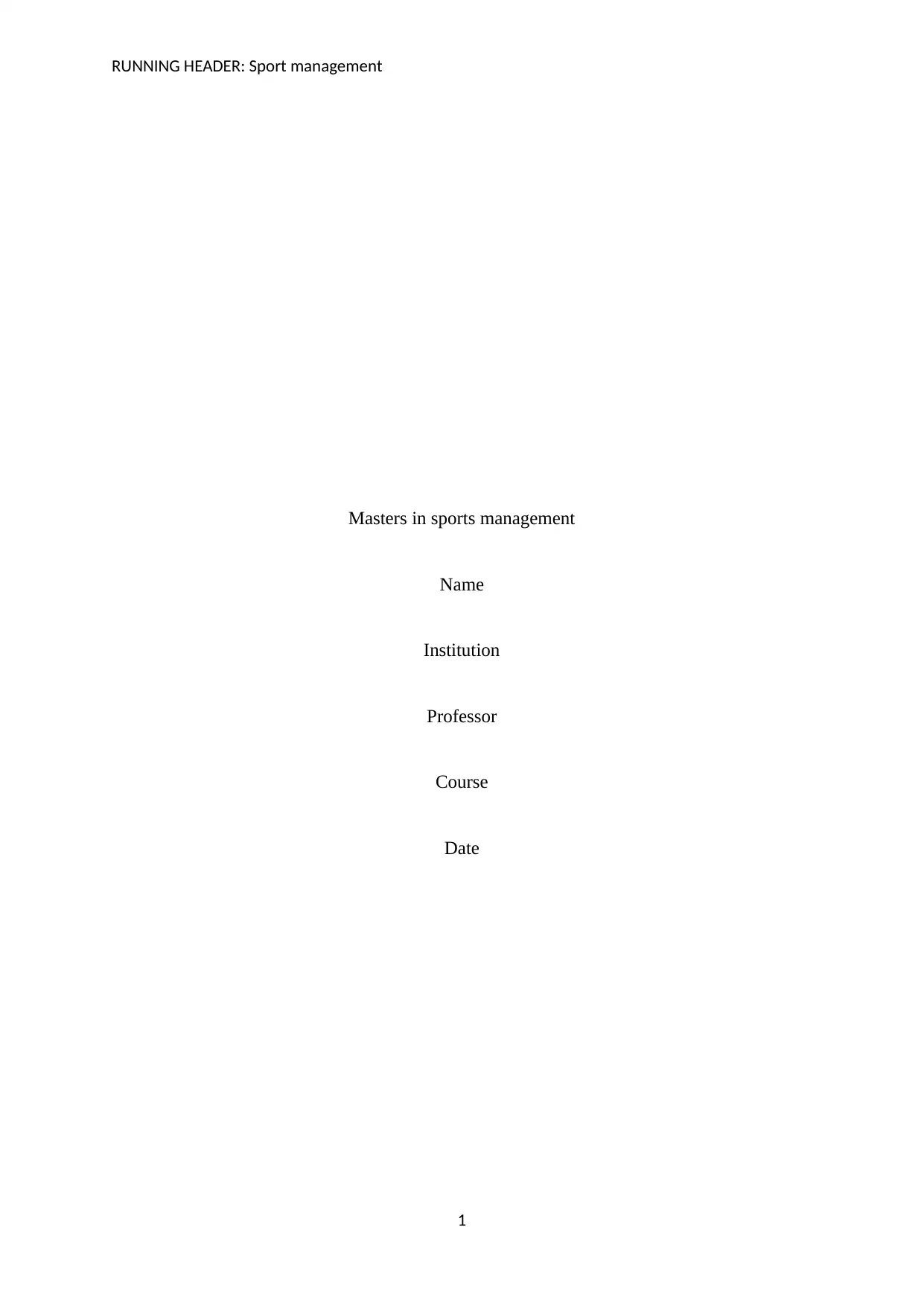
RUNNING HEADER: Sport management
Masters in sports management
Name
Institution
Professor
Course
Date
1
Masters in sports management
Name
Institution
Professor
Course
Date
1
Secure Best Marks with AI Grader
Need help grading? Try our AI Grader for instant feedback on your assignments.
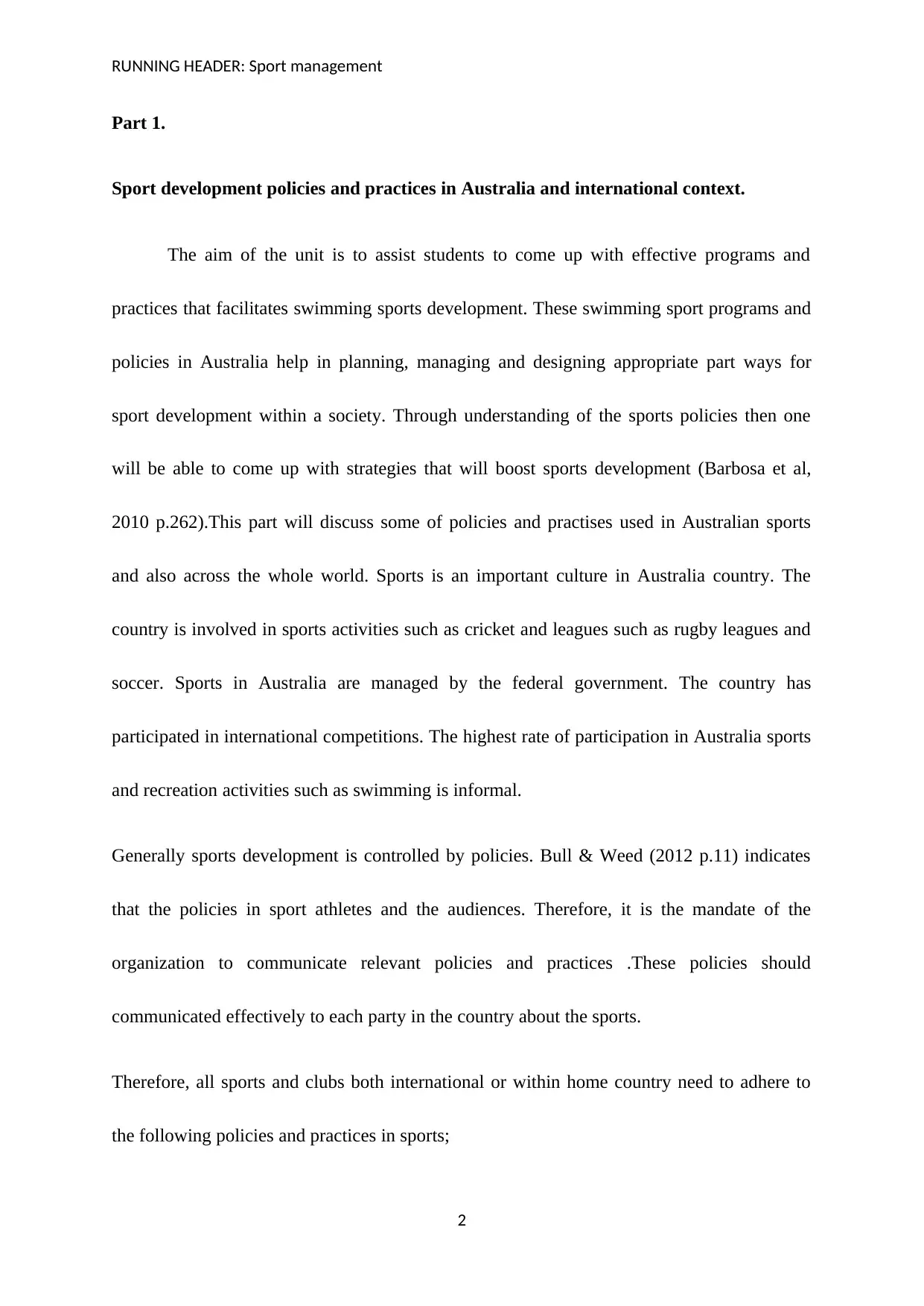
RUNNING HEADER: Sport management
Part 1.
Sport development policies and practices in Australia and international context.
The aim of the unit is to assist students to come up with effective programs and
practices that facilitates swimming sports development. These swimming sport programs and
policies in Australia help in planning, managing and designing appropriate part ways for
sport development within a society. Through understanding of the sports policies then one
will be able to come up with strategies that will boost sports development (Barbosa et al,
2010 p.262).This part will discuss some of policies and practises used in Australian sports
and also across the whole world. Sports is an important culture in Australia country. The
country is involved in sports activities such as cricket and leagues such as rugby leagues and
soccer. Sports in Australia are managed by the federal government. The country has
participated in international competitions. The highest rate of participation in Australia sports
and recreation activities such as swimming is informal.
Generally sports development is controlled by policies. Bull & Weed (2012 p.11) indicates
that the policies in sport athletes and the audiences. Therefore, it is the mandate of the
organization to communicate relevant policies and practices .These policies should
communicated effectively to each party in the country about the sports.
Therefore, all sports and clubs both international or within home country need to adhere to
the following policies and practices in sports;
2
Part 1.
Sport development policies and practices in Australia and international context.
The aim of the unit is to assist students to come up with effective programs and
practices that facilitates swimming sports development. These swimming sport programs and
policies in Australia help in planning, managing and designing appropriate part ways for
sport development within a society. Through understanding of the sports policies then one
will be able to come up with strategies that will boost sports development (Barbosa et al,
2010 p.262).This part will discuss some of policies and practises used in Australian sports
and also across the whole world. Sports is an important culture in Australia country. The
country is involved in sports activities such as cricket and leagues such as rugby leagues and
soccer. Sports in Australia are managed by the federal government. The country has
participated in international competitions. The highest rate of participation in Australia sports
and recreation activities such as swimming is informal.
Generally sports development is controlled by policies. Bull & Weed (2012 p.11) indicates
that the policies in sport athletes and the audiences. Therefore, it is the mandate of the
organization to communicate relevant policies and practices .These policies should
communicated effectively to each party in the country about the sports.
Therefore, all sports and clubs both international or within home country need to adhere to
the following policies and practices in sports;
2
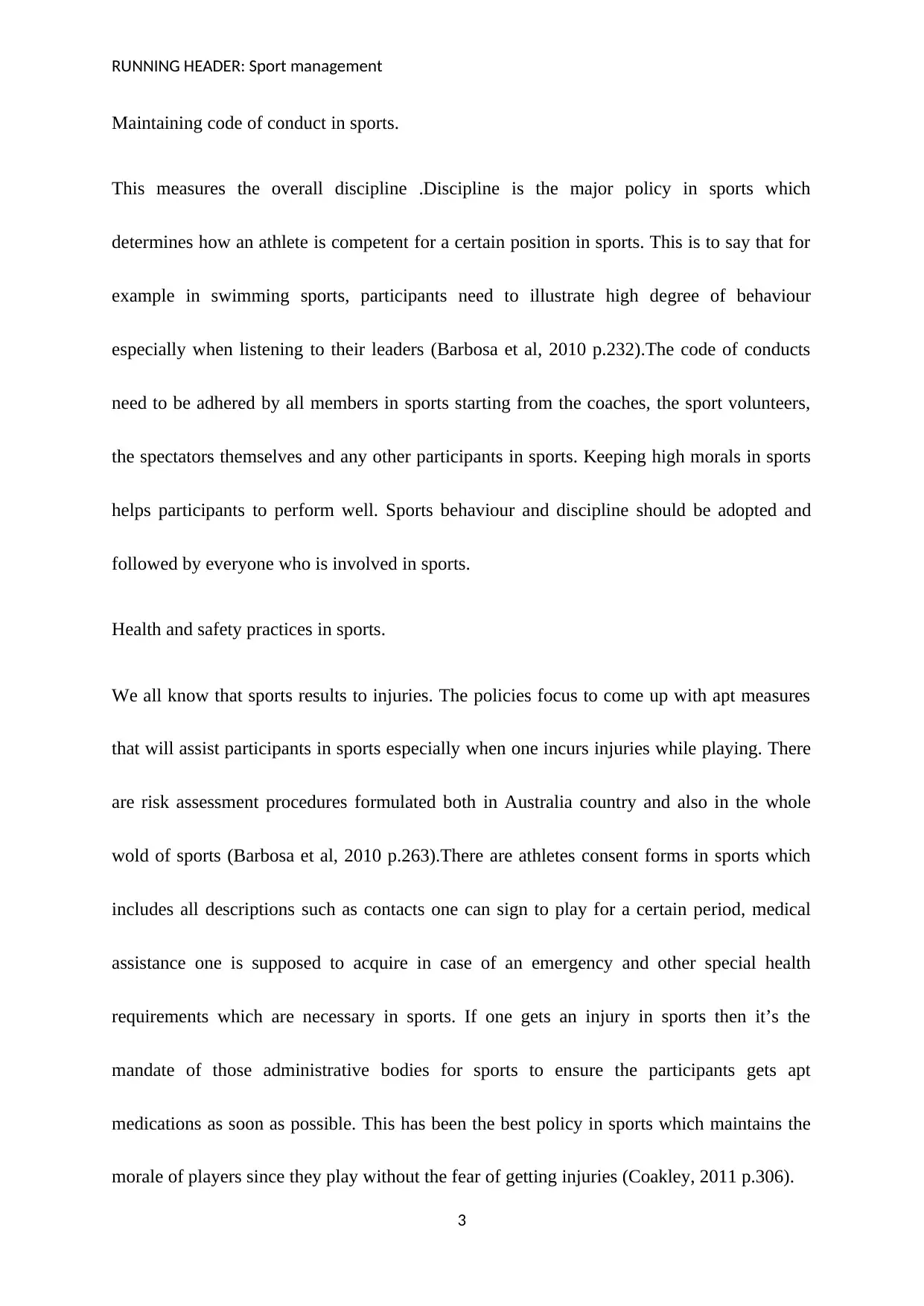
RUNNING HEADER: Sport management
Maintaining code of conduct in sports.
This measures the overall discipline .Discipline is the major policy in sports which
determines how an athlete is competent for a certain position in sports. This is to say that for
example in swimming sports, participants need to illustrate high degree of behaviour
especially when listening to their leaders (Barbosa et al, 2010 p.232).The code of conducts
need to be adhered by all members in sports starting from the coaches, the sport volunteers,
the spectators themselves and any other participants in sports. Keeping high morals in sports
helps participants to perform well. Sports behaviour and discipline should be adopted and
followed by everyone who is involved in sports.
Health and safety practices in sports.
We all know that sports results to injuries. The policies focus to come up with apt measures
that will assist participants in sports especially when one incurs injuries while playing. There
are risk assessment procedures formulated both in Australia country and also in the whole
wold of sports (Barbosa et al, 2010 p.263).There are athletes consent forms in sports which
includes all descriptions such as contacts one can sign to play for a certain period, medical
assistance one is supposed to acquire in case of an emergency and other special health
requirements which are necessary in sports. If one gets an injury in sports then it’s the
mandate of those administrative bodies for sports to ensure the participants gets apt
medications as soon as possible. This has been the best policy in sports which maintains the
morale of players since they play without the fear of getting injuries (Coakley, 2011 p.306).
3
Maintaining code of conduct in sports.
This measures the overall discipline .Discipline is the major policy in sports which
determines how an athlete is competent for a certain position in sports. This is to say that for
example in swimming sports, participants need to illustrate high degree of behaviour
especially when listening to their leaders (Barbosa et al, 2010 p.232).The code of conducts
need to be adhered by all members in sports starting from the coaches, the sport volunteers,
the spectators themselves and any other participants in sports. Keeping high morals in sports
helps participants to perform well. Sports behaviour and discipline should be adopted and
followed by everyone who is involved in sports.
Health and safety practices in sports.
We all know that sports results to injuries. The policies focus to come up with apt measures
that will assist participants in sports especially when one incurs injuries while playing. There
are risk assessment procedures formulated both in Australia country and also in the whole
wold of sports (Barbosa et al, 2010 p.263).There are athletes consent forms in sports which
includes all descriptions such as contacts one can sign to play for a certain period, medical
assistance one is supposed to acquire in case of an emergency and other special health
requirements which are necessary in sports. If one gets an injury in sports then it’s the
mandate of those administrative bodies for sports to ensure the participants gets apt
medications as soon as possible. This has been the best policy in sports which maintains the
morale of players since they play without the fear of getting injuries (Coakley, 2011 p.306).
3
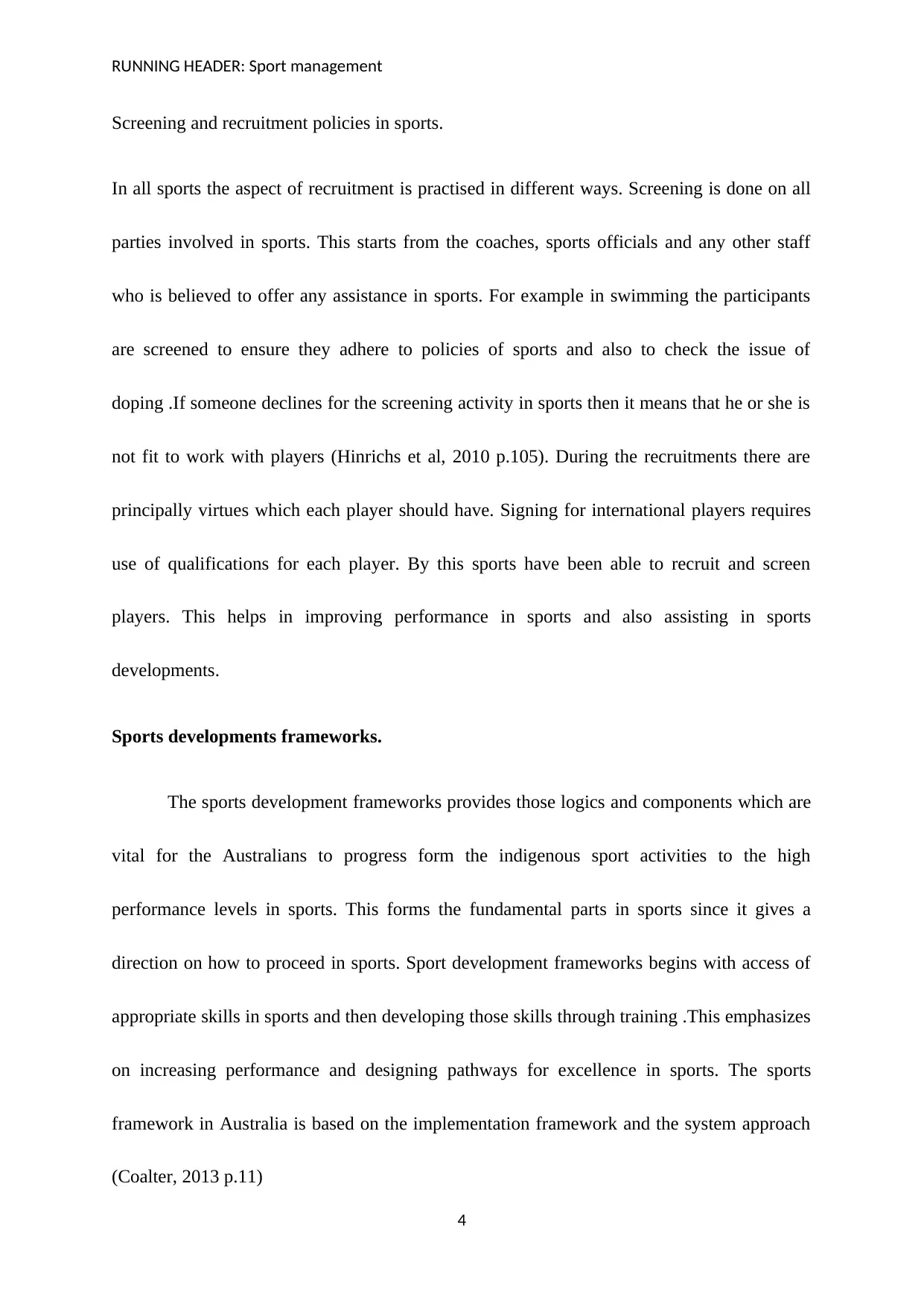
RUNNING HEADER: Sport management
Screening and recruitment policies in sports.
In all sports the aspect of recruitment is practised in different ways. Screening is done on all
parties involved in sports. This starts from the coaches, sports officials and any other staff
who is believed to offer any assistance in sports. For example in swimming the participants
are screened to ensure they adhere to policies of sports and also to check the issue of
doping .If someone declines for the screening activity in sports then it means that he or she is
not fit to work with players (Hinrichs et al, 2010 p.105). During the recruitments there are
principally virtues which each player should have. Signing for international players requires
use of qualifications for each player. By this sports have been able to recruit and screen
players. This helps in improving performance in sports and also assisting in sports
developments.
Sports developments frameworks.
The sports development frameworks provides those logics and components which are
vital for the Australians to progress form the indigenous sport activities to the high
performance levels in sports. This forms the fundamental parts in sports since it gives a
direction on how to proceed in sports. Sport development frameworks begins with access of
appropriate skills in sports and then developing those skills through training .This emphasizes
on increasing performance and designing pathways for excellence in sports. The sports
framework in Australia is based on the implementation framework and the system approach
(Coalter, 2013 p.11)
4
Screening and recruitment policies in sports.
In all sports the aspect of recruitment is practised in different ways. Screening is done on all
parties involved in sports. This starts from the coaches, sports officials and any other staff
who is believed to offer any assistance in sports. For example in swimming the participants
are screened to ensure they adhere to policies of sports and also to check the issue of
doping .If someone declines for the screening activity in sports then it means that he or she is
not fit to work with players (Hinrichs et al, 2010 p.105). During the recruitments there are
principally virtues which each player should have. Signing for international players requires
use of qualifications for each player. By this sports have been able to recruit and screen
players. This helps in improving performance in sports and also assisting in sports
developments.
Sports developments frameworks.
The sports development frameworks provides those logics and components which are
vital for the Australians to progress form the indigenous sport activities to the high
performance levels in sports. This forms the fundamental parts in sports since it gives a
direction on how to proceed in sports. Sport development frameworks begins with access of
appropriate skills in sports and then developing those skills through training .This emphasizes
on increasing performance and designing pathways for excellence in sports. The sports
framework in Australia is based on the implementation framework and the system approach
(Coalter, 2013 p.11)
4
Secure Best Marks with AI Grader
Need help grading? Try our AI Grader for instant feedback on your assignments.
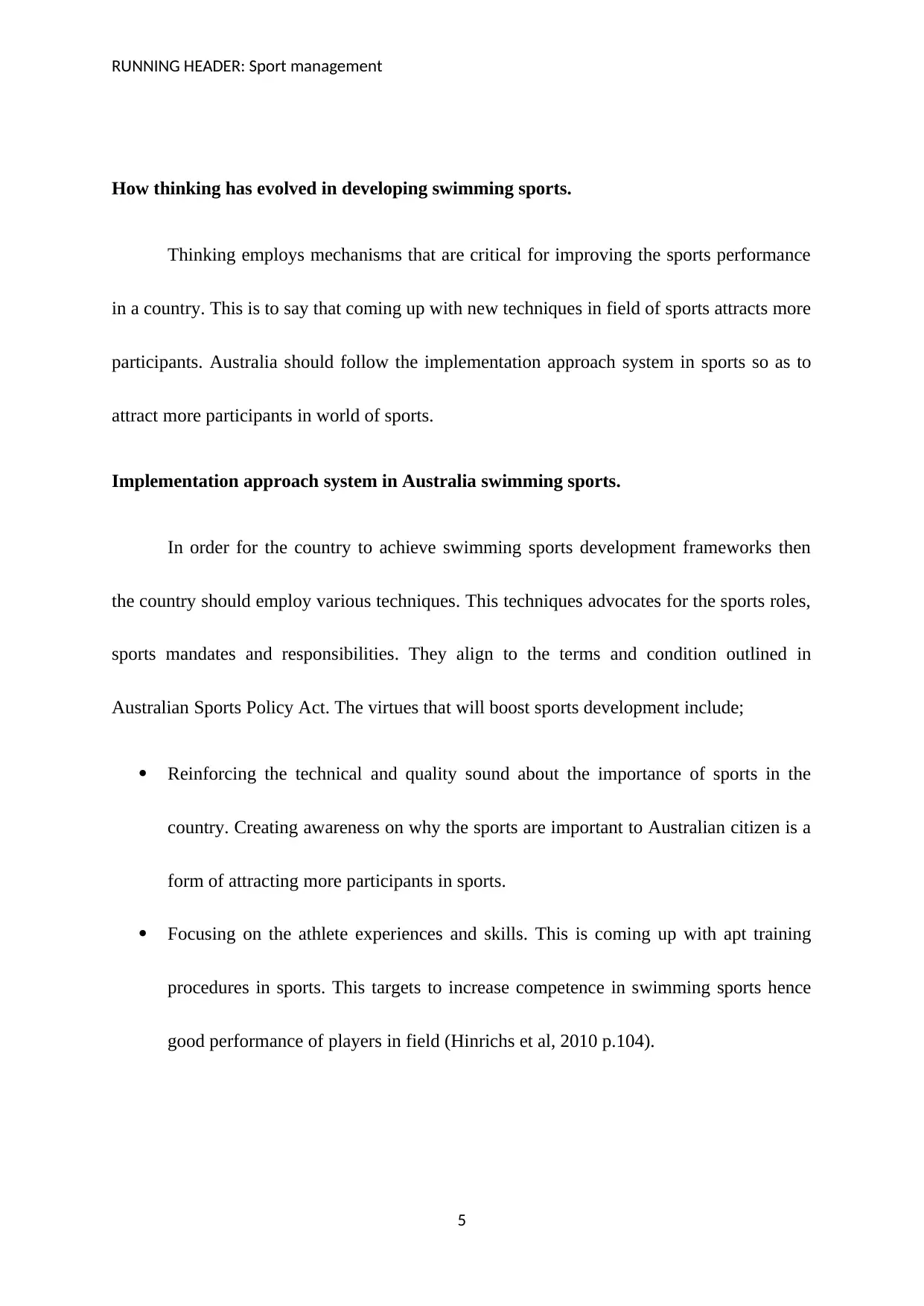
RUNNING HEADER: Sport management
How thinking has evolved in developing swimming sports.
Thinking employs mechanisms that are critical for improving the sports performance
in a country. This is to say that coming up with new techniques in field of sports attracts more
participants. Australia should follow the implementation approach system in sports so as to
attract more participants in world of sports.
Implementation approach system in Australia swimming sports.
In order for the country to achieve swimming sports development frameworks then
the country should employ various techniques. This techniques advocates for the sports roles,
sports mandates and responsibilities. They align to the terms and condition outlined in
Australian Sports Policy Act. The virtues that will boost sports development include;
Reinforcing the technical and quality sound about the importance of sports in the
country. Creating awareness on why the sports are important to Australian citizen is a
form of attracting more participants in sports.
Focusing on the athlete experiences and skills. This is coming up with apt training
procedures in sports. This targets to increase competence in swimming sports hence
good performance of players in field (Hinrichs et al, 2010 p.104).
5
How thinking has evolved in developing swimming sports.
Thinking employs mechanisms that are critical for improving the sports performance
in a country. This is to say that coming up with new techniques in field of sports attracts more
participants. Australia should follow the implementation approach system in sports so as to
attract more participants in world of sports.
Implementation approach system in Australia swimming sports.
In order for the country to achieve swimming sports development frameworks then
the country should employ various techniques. This techniques advocates for the sports roles,
sports mandates and responsibilities. They align to the terms and condition outlined in
Australian Sports Policy Act. The virtues that will boost sports development include;
Reinforcing the technical and quality sound about the importance of sports in the
country. Creating awareness on why the sports are important to Australian citizen is a
form of attracting more participants in sports.
Focusing on the athlete experiences and skills. This is coming up with apt training
procedures in sports. This targets to increase competence in swimming sports hence
good performance of players in field (Hinrichs et al, 2010 p.104).
5
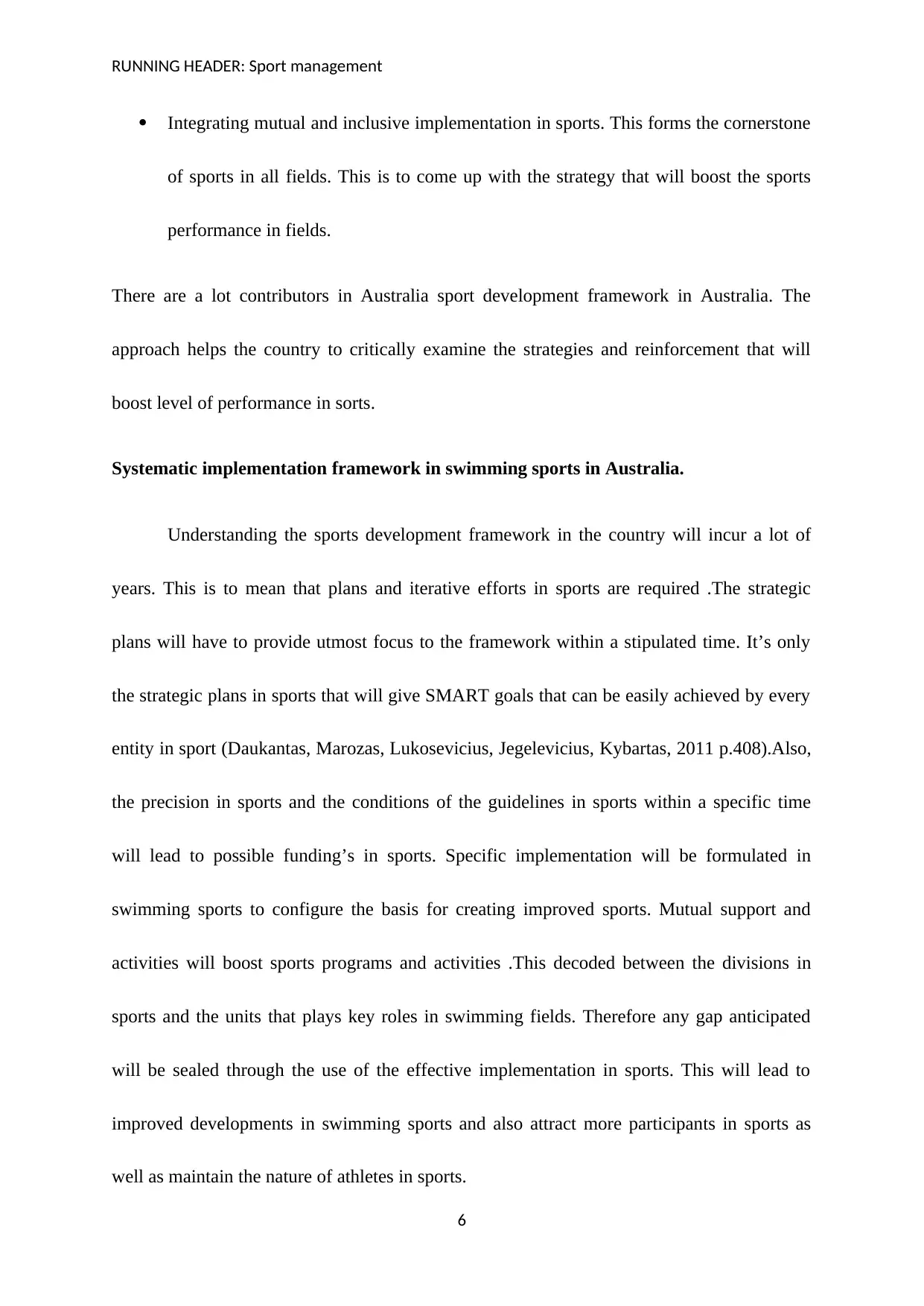
RUNNING HEADER: Sport management
Integrating mutual and inclusive implementation in sports. This forms the cornerstone
of sports in all fields. This is to come up with the strategy that will boost the sports
performance in fields.
There are a lot contributors in Australia sport development framework in Australia. The
approach helps the country to critically examine the strategies and reinforcement that will
boost level of performance in sorts.
Systematic implementation framework in swimming sports in Australia.
Understanding the sports development framework in the country will incur a lot of
years. This is to mean that plans and iterative efforts in sports are required .The strategic
plans will have to provide utmost focus to the framework within a stipulated time. It’s only
the strategic plans in sports that will give SMART goals that can be easily achieved by every
entity in sport (Daukantas, Marozas, Lukosevicius, Jegelevicius, Kybartas, 2011 p.408).Also,
the precision in sports and the conditions of the guidelines in sports within a specific time
will lead to possible funding’s in sports. Specific implementation will be formulated in
swimming sports to configure the basis for creating improved sports. Mutual support and
activities will boost sports programs and activities .This decoded between the divisions in
sports and the units that plays key roles in swimming fields. Therefore any gap anticipated
will be sealed through the use of the effective implementation in sports. This will lead to
improved developments in swimming sports and also attract more participants in sports as
well as maintain the nature of athletes in sports.
6
Integrating mutual and inclusive implementation in sports. This forms the cornerstone
of sports in all fields. This is to come up with the strategy that will boost the sports
performance in fields.
There are a lot contributors in Australia sport development framework in Australia. The
approach helps the country to critically examine the strategies and reinforcement that will
boost level of performance in sorts.
Systematic implementation framework in swimming sports in Australia.
Understanding the sports development framework in the country will incur a lot of
years. This is to mean that plans and iterative efforts in sports are required .The strategic
plans will have to provide utmost focus to the framework within a stipulated time. It’s only
the strategic plans in sports that will give SMART goals that can be easily achieved by every
entity in sport (Daukantas, Marozas, Lukosevicius, Jegelevicius, Kybartas, 2011 p.408).Also,
the precision in sports and the conditions of the guidelines in sports within a specific time
will lead to possible funding’s in sports. Specific implementation will be formulated in
swimming sports to configure the basis for creating improved sports. Mutual support and
activities will boost sports programs and activities .This decoded between the divisions in
sports and the units that plays key roles in swimming fields. Therefore any gap anticipated
will be sealed through the use of the effective implementation in sports. This will lead to
improved developments in swimming sports and also attract more participants in sports as
well as maintain the nature of athletes in sports.
6
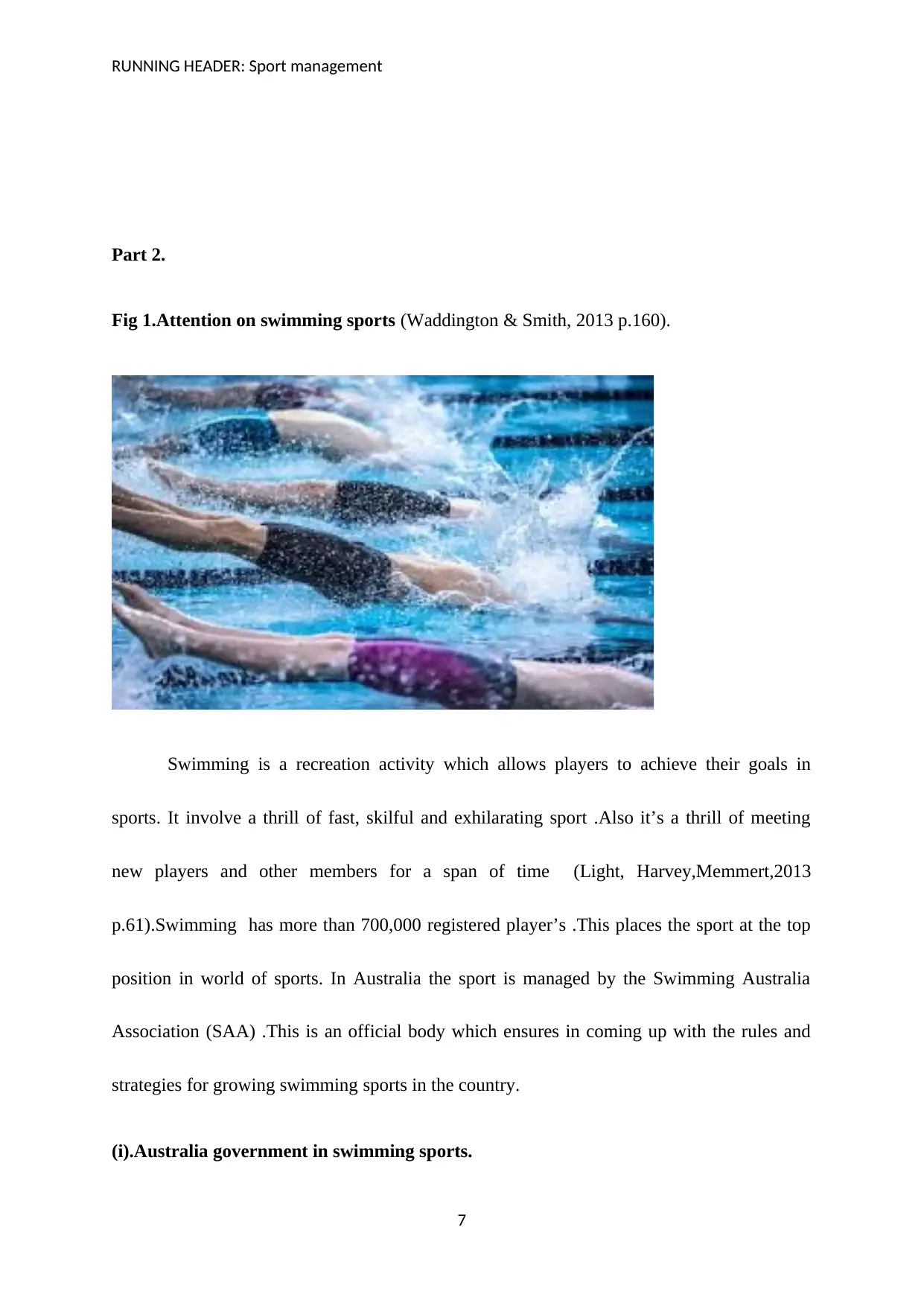
RUNNING HEADER: Sport management
Part 2.
Fig 1.Attention on swimming sports (Waddington & Smith, 2013 p.160).
Swimming is a recreation activity which allows players to achieve their goals in
sports. It involve a thrill of fast, skilful and exhilarating sport .Also it’s a thrill of meeting
new players and other members for a span of time (Light, Harvey,Memmert,2013
p.61).Swimming has more than 700,000 registered player’s .This places the sport at the top
position in world of sports. In Australia the sport is managed by the Swimming Australia
Association (SAA) .This is an official body which ensures in coming up with the rules and
strategies for growing swimming sports in the country.
(i).Australia government in swimming sports.
7
Part 2.
Fig 1.Attention on swimming sports (Waddington & Smith, 2013 p.160).
Swimming is a recreation activity which allows players to achieve their goals in
sports. It involve a thrill of fast, skilful and exhilarating sport .Also it’s a thrill of meeting
new players and other members for a span of time (Light, Harvey,Memmert,2013
p.61).Swimming has more than 700,000 registered player’s .This places the sport at the top
position in world of sports. In Australia the sport is managed by the Swimming Australia
Association (SAA) .This is an official body which ensures in coming up with the rules and
strategies for growing swimming sports in the country.
(i).Australia government in swimming sports.
7
Paraphrase This Document
Need a fresh take? Get an instant paraphrase of this document with our AI Paraphraser
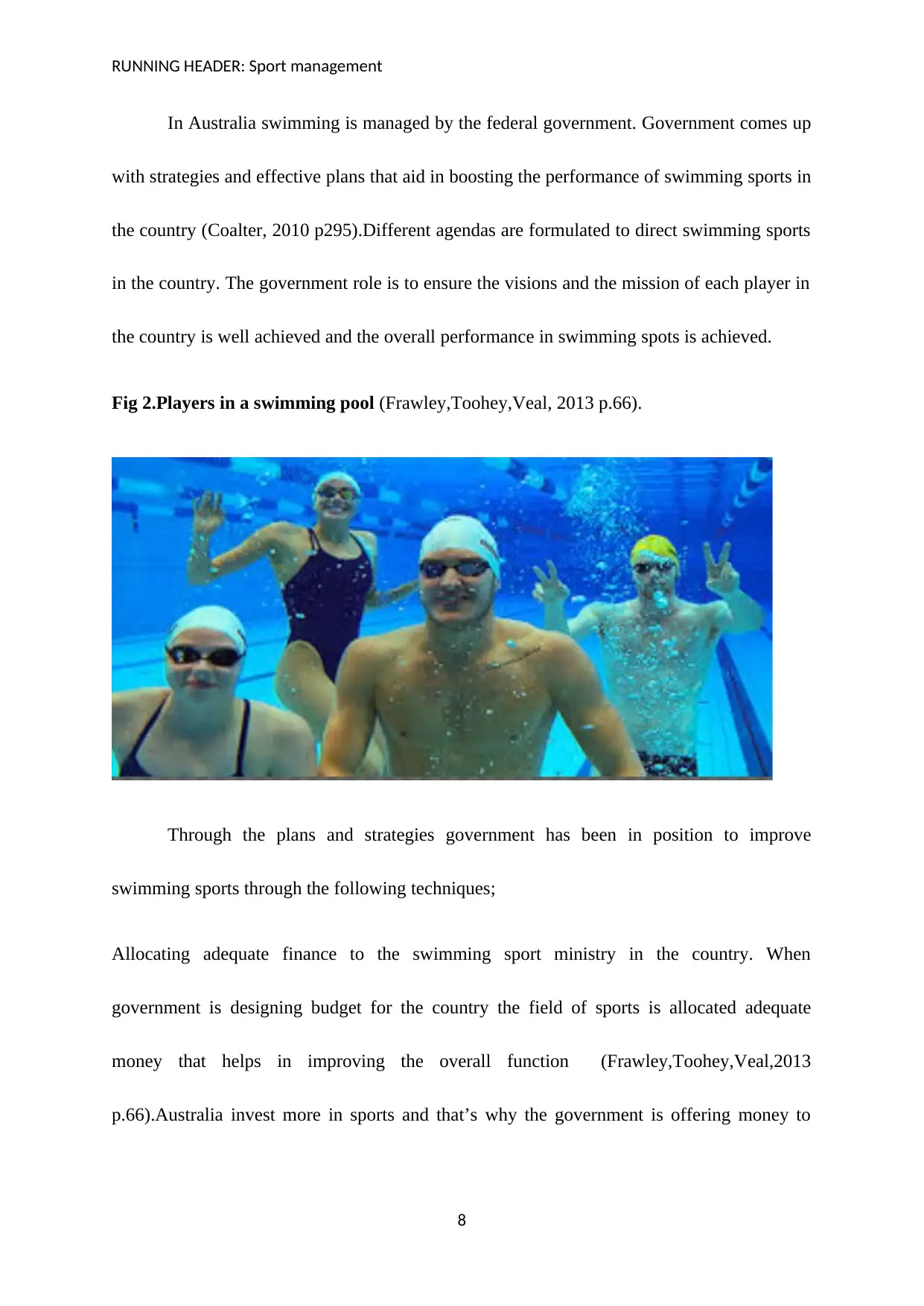
RUNNING HEADER: Sport management
In Australia swimming is managed by the federal government. Government comes up
with strategies and effective plans that aid in boosting the performance of swimming sports in
the country (Coalter, 2010 p295).Different agendas are formulated to direct swimming sports
in the country. The government role is to ensure the visions and the mission of each player in
the country is well achieved and the overall performance in swimming spots is achieved.
Fig 2.Players in a swimming pool (Frawley,Toohey,Veal, 2013 p.66).
Through the plans and strategies government has been in position to improve
swimming sports through the following techniques;
Allocating adequate finance to the swimming sport ministry in the country. When
government is designing budget for the country the field of sports is allocated adequate
money that helps in improving the overall function (Frawley,Toohey,Veal,2013
p.66).Australia invest more in sports and that’s why the government is offering money to
8
In Australia swimming is managed by the federal government. Government comes up
with strategies and effective plans that aid in boosting the performance of swimming sports in
the country (Coalter, 2010 p295).Different agendas are formulated to direct swimming sports
in the country. The government role is to ensure the visions and the mission of each player in
the country is well achieved and the overall performance in swimming spots is achieved.
Fig 2.Players in a swimming pool (Frawley,Toohey,Veal, 2013 p.66).
Through the plans and strategies government has been in position to improve
swimming sports through the following techniques;
Allocating adequate finance to the swimming sport ministry in the country. When
government is designing budget for the country the field of sports is allocated adequate
money that helps in improving the overall function (Frawley,Toohey,Veal,2013
p.66).Australia invest more in sports and that’s why the government is offering money to
8
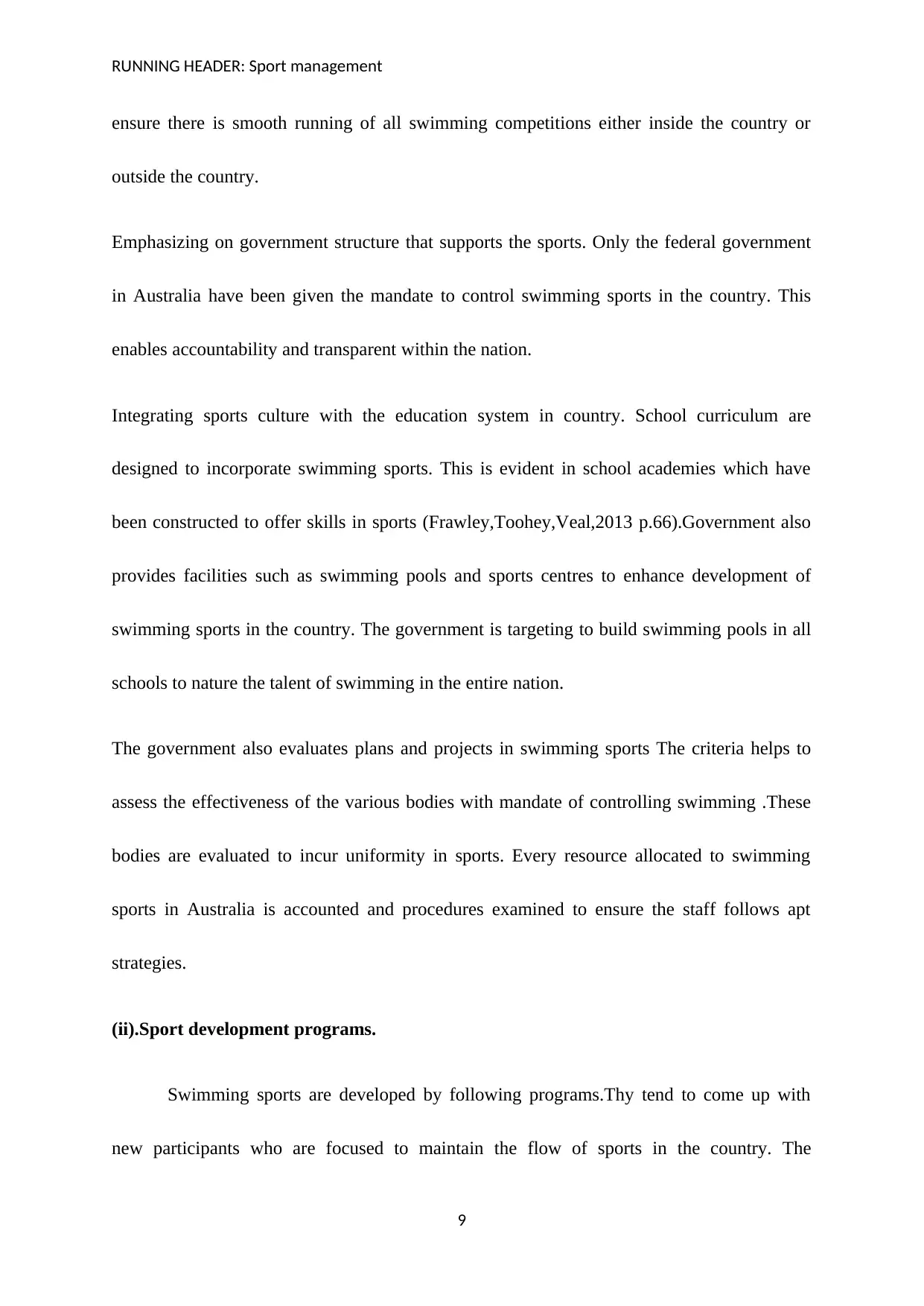
RUNNING HEADER: Sport management
ensure there is smooth running of all swimming competitions either inside the country or
outside the country.
Emphasizing on government structure that supports the sports. Only the federal government
in Australia have been given the mandate to control swimming sports in the country. This
enables accountability and transparent within the nation.
Integrating sports culture with the education system in country. School curriculum are
designed to incorporate swimming sports. This is evident in school academies which have
been constructed to offer skills in sports (Frawley,Toohey,Veal,2013 p.66).Government also
provides facilities such as swimming pools and sports centres to enhance development of
swimming sports in the country. The government is targeting to build swimming pools in all
schools to nature the talent of swimming in the entire nation.
The government also evaluates plans and projects in swimming sports The criteria helps to
assess the effectiveness of the various bodies with mandate of controlling swimming .These
bodies are evaluated to incur uniformity in sports. Every resource allocated to swimming
sports in Australia is accounted and procedures examined to ensure the staff follows apt
strategies.
(ii).Sport development programs.
Swimming sports are developed by following programs.Thy tend to come up with
new participants who are focused to maintain the flow of sports in the country. The
9
ensure there is smooth running of all swimming competitions either inside the country or
outside the country.
Emphasizing on government structure that supports the sports. Only the federal government
in Australia have been given the mandate to control swimming sports in the country. This
enables accountability and transparent within the nation.
Integrating sports culture with the education system in country. School curriculum are
designed to incorporate swimming sports. This is evident in school academies which have
been constructed to offer skills in sports (Frawley,Toohey,Veal,2013 p.66).Government also
provides facilities such as swimming pools and sports centres to enhance development of
swimming sports in the country. The government is targeting to build swimming pools in all
schools to nature the talent of swimming in the entire nation.
The government also evaluates plans and projects in swimming sports The criteria helps to
assess the effectiveness of the various bodies with mandate of controlling swimming .These
bodies are evaluated to incur uniformity in sports. Every resource allocated to swimming
sports in Australia is accounted and procedures examined to ensure the staff follows apt
strategies.
(ii).Sport development programs.
Swimming sports are developed by following programs.Thy tend to come up with
new participants who are focused to maintain the flow of sports in the country. The
9
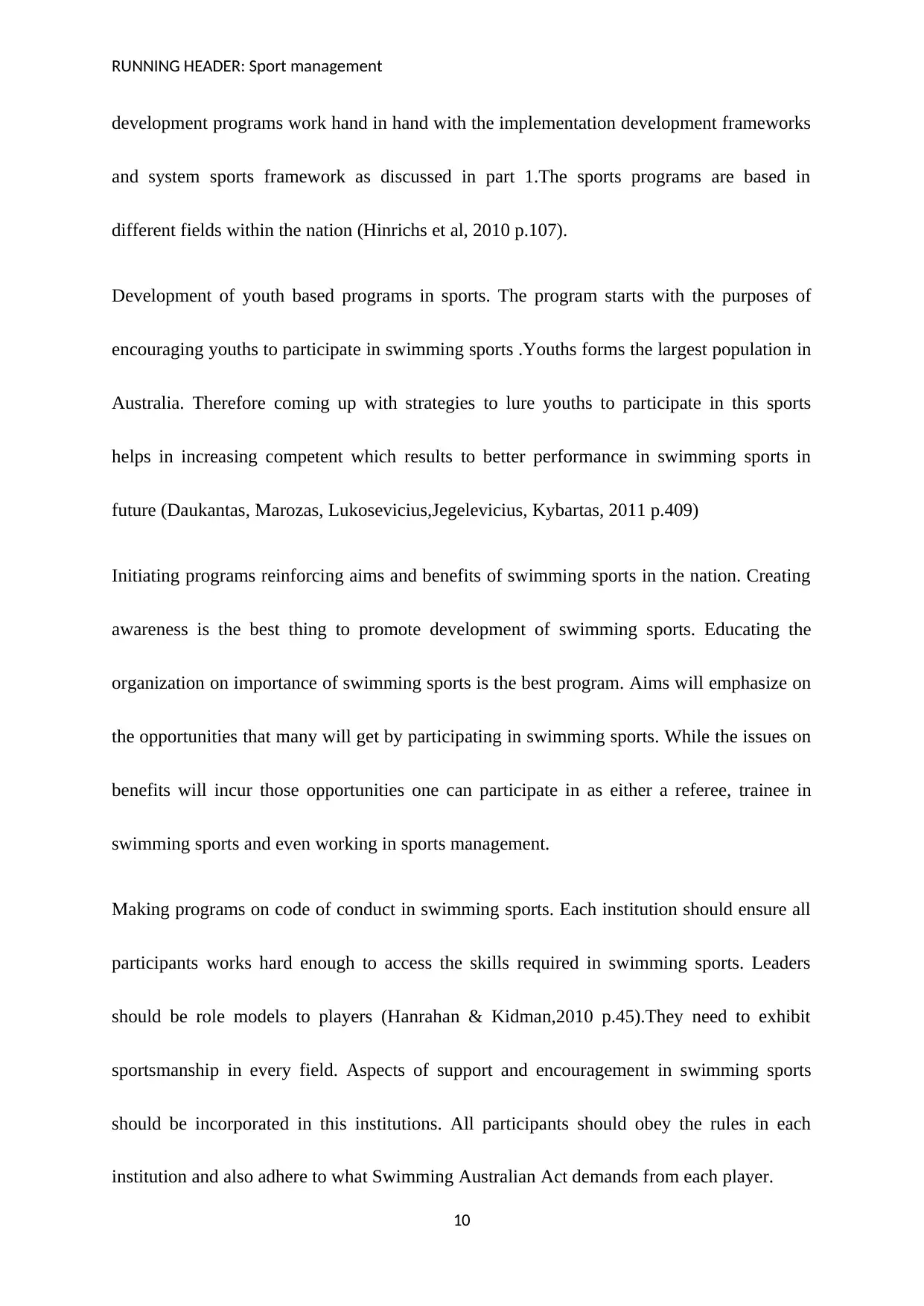
RUNNING HEADER: Sport management
development programs work hand in hand with the implementation development frameworks
and system sports framework as discussed in part 1.The sports programs are based in
different fields within the nation (Hinrichs et al, 2010 p.107).
Development of youth based programs in sports. The program starts with the purposes of
encouraging youths to participate in swimming sports .Youths forms the largest population in
Australia. Therefore coming up with strategies to lure youths to participate in this sports
helps in increasing competent which results to better performance in swimming sports in
future (Daukantas, Marozas, Lukosevicius,Jegelevicius, Kybartas, 2011 p.409)
Initiating programs reinforcing aims and benefits of swimming sports in the nation. Creating
awareness is the best thing to promote development of swimming sports. Educating the
organization on importance of swimming sports is the best program. Aims will emphasize on
the opportunities that many will get by participating in swimming sports. While the issues on
benefits will incur those opportunities one can participate in as either a referee, trainee in
swimming sports and even working in sports management.
Making programs on code of conduct in swimming sports. Each institution should ensure all
participants works hard enough to access the skills required in swimming sports. Leaders
should be role models to players (Hanrahan & Kidman,2010 p.45).They need to exhibit
sportsmanship in every field. Aspects of support and encouragement in swimming sports
should be incorporated in this institutions. All participants should obey the rules in each
institution and also adhere to what Swimming Australian Act demands from each player.
10
development programs work hand in hand with the implementation development frameworks
and system sports framework as discussed in part 1.The sports programs are based in
different fields within the nation (Hinrichs et al, 2010 p.107).
Development of youth based programs in sports. The program starts with the purposes of
encouraging youths to participate in swimming sports .Youths forms the largest population in
Australia. Therefore coming up with strategies to lure youths to participate in this sports
helps in increasing competent which results to better performance in swimming sports in
future (Daukantas, Marozas, Lukosevicius,Jegelevicius, Kybartas, 2011 p.409)
Initiating programs reinforcing aims and benefits of swimming sports in the nation. Creating
awareness is the best thing to promote development of swimming sports. Educating the
organization on importance of swimming sports is the best program. Aims will emphasize on
the opportunities that many will get by participating in swimming sports. While the issues on
benefits will incur those opportunities one can participate in as either a referee, trainee in
swimming sports and even working in sports management.
Making programs on code of conduct in swimming sports. Each institution should ensure all
participants works hard enough to access the skills required in swimming sports. Leaders
should be role models to players (Hanrahan & Kidman,2010 p.45).They need to exhibit
sportsmanship in every field. Aspects of support and encouragement in swimming sports
should be incorporated in this institutions. All participants should obey the rules in each
institution and also adhere to what Swimming Australian Act demands from each player.
10
Secure Best Marks with AI Grader
Need help grading? Try our AI Grader for instant feedback on your assignments.
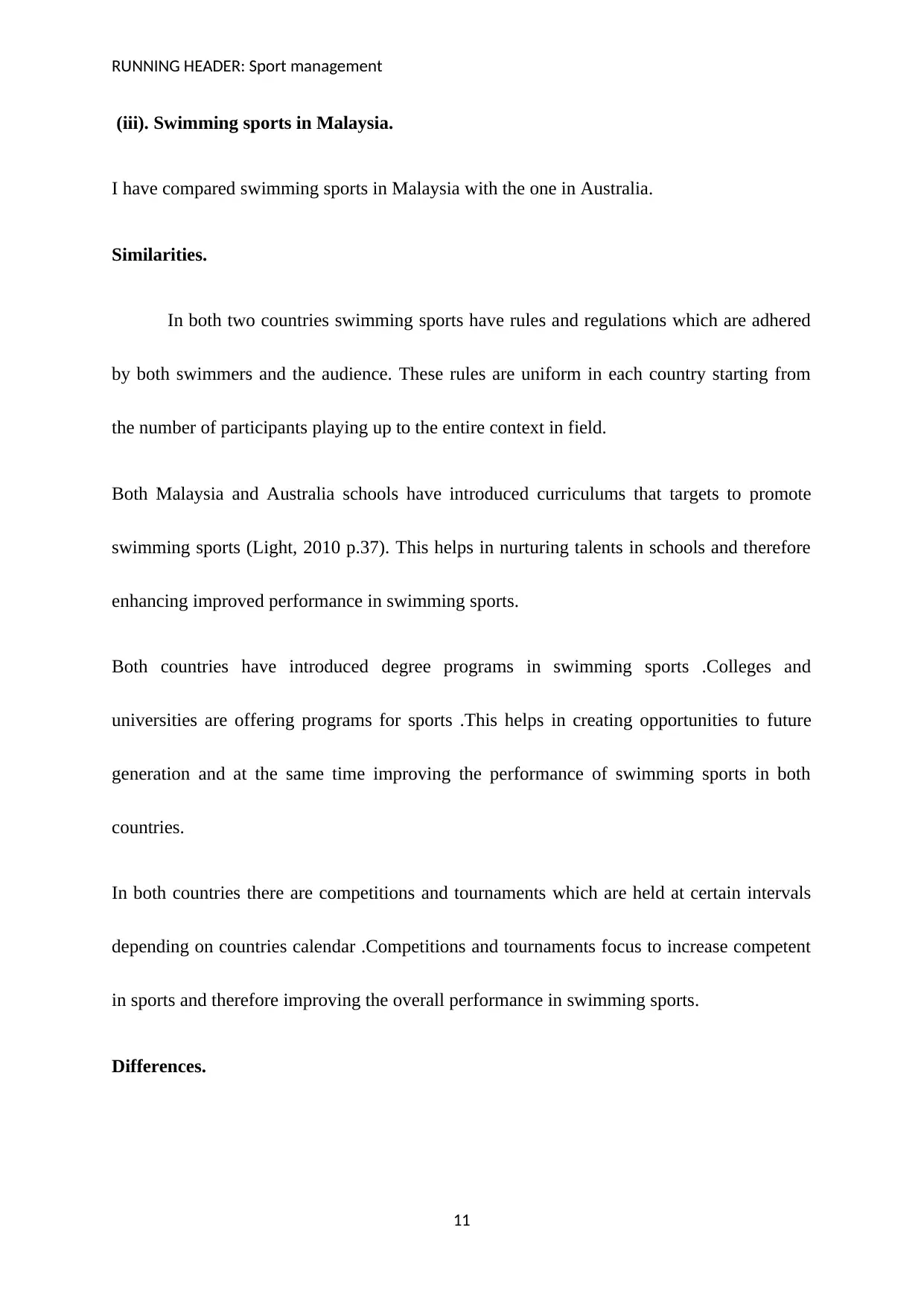
RUNNING HEADER: Sport management
(iii). Swimming sports in Malaysia.
I have compared swimming sports in Malaysia with the one in Australia.
Similarities.
In both two countries swimming sports have rules and regulations which are adhered
by both swimmers and the audience. These rules are uniform in each country starting from
the number of participants playing up to the entire context in field.
Both Malaysia and Australia schools have introduced curriculums that targets to promote
swimming sports (Light, 2010 p.37). This helps in nurturing talents in schools and therefore
enhancing improved performance in swimming sports.
Both countries have introduced degree programs in swimming sports .Colleges and
universities are offering programs for sports .This helps in creating opportunities to future
generation and at the same time improving the performance of swimming sports in both
countries.
In both countries there are competitions and tournaments which are held at certain intervals
depending on countries calendar .Competitions and tournaments focus to increase competent
in sports and therefore improving the overall performance in swimming sports.
Differences.
11
(iii). Swimming sports in Malaysia.
I have compared swimming sports in Malaysia with the one in Australia.
Similarities.
In both two countries swimming sports have rules and regulations which are adhered
by both swimmers and the audience. These rules are uniform in each country starting from
the number of participants playing up to the entire context in field.
Both Malaysia and Australia schools have introduced curriculums that targets to promote
swimming sports (Light, 2010 p.37). This helps in nurturing talents in schools and therefore
enhancing improved performance in swimming sports.
Both countries have introduced degree programs in swimming sports .Colleges and
universities are offering programs for sports .This helps in creating opportunities to future
generation and at the same time improving the performance of swimming sports in both
countries.
In both countries there are competitions and tournaments which are held at certain intervals
depending on countries calendar .Competitions and tournaments focus to increase competent
in sports and therefore improving the overall performance in swimming sports.
Differences.
11
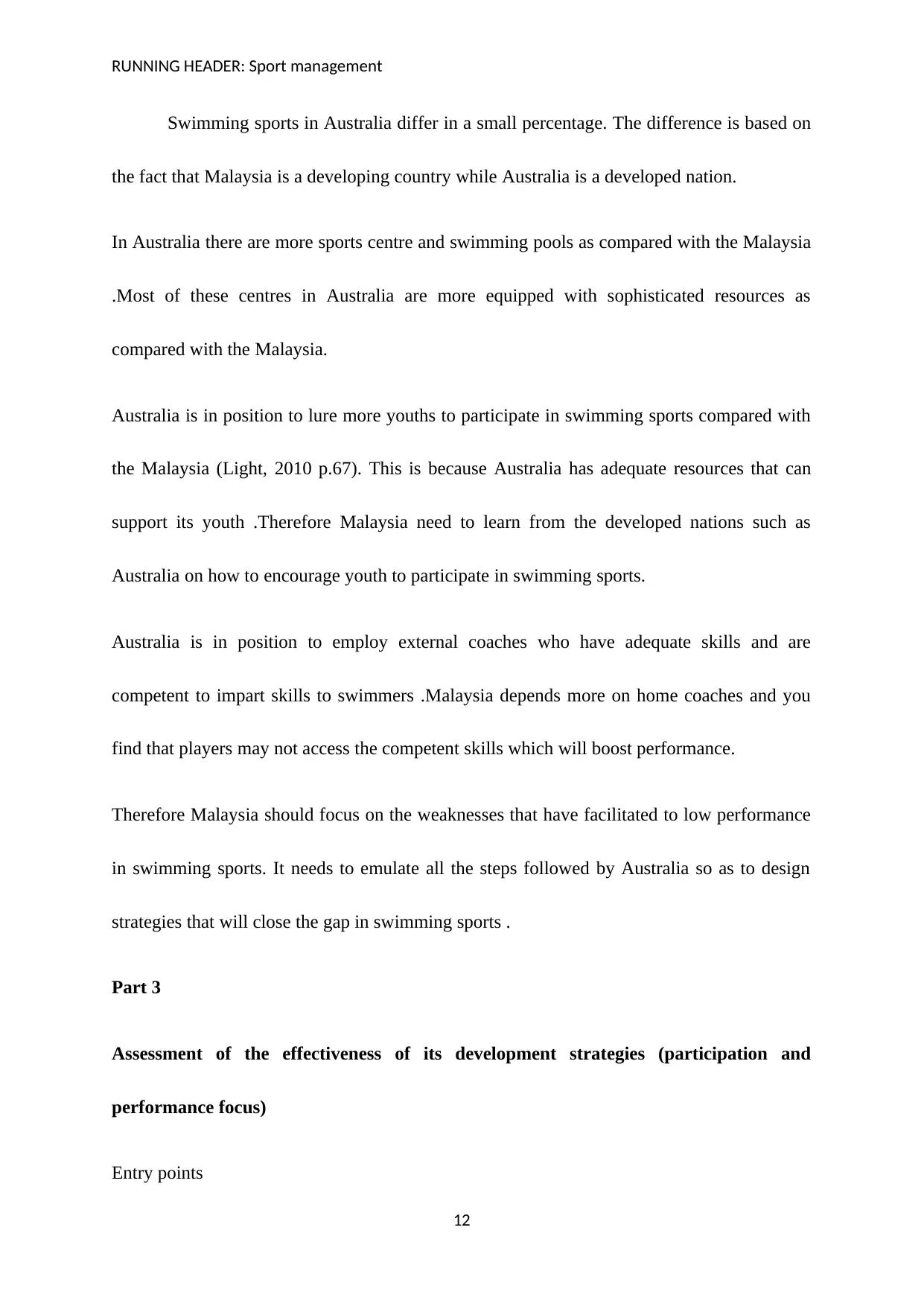
RUNNING HEADER: Sport management
Swimming sports in Australia differ in a small percentage. The difference is based on
the fact that Malaysia is a developing country while Australia is a developed nation.
In Australia there are more sports centre and swimming pools as compared with the Malaysia
.Most of these centres in Australia are more equipped with sophisticated resources as
compared with the Malaysia.
Australia is in position to lure more youths to participate in swimming sports compared with
the Malaysia (Light, 2010 p.67). This is because Australia has adequate resources that can
support its youth .Therefore Malaysia need to learn from the developed nations such as
Australia on how to encourage youth to participate in swimming sports.
Australia is in position to employ external coaches who have adequate skills and are
competent to impart skills to swimmers .Malaysia depends more on home coaches and you
find that players may not access the competent skills which will boost performance.
Therefore Malaysia should focus on the weaknesses that have facilitated to low performance
in swimming sports. It needs to emulate all the steps followed by Australia so as to design
strategies that will close the gap in swimming sports .
Part 3
Assessment of the effectiveness of its development strategies (participation and
performance focus)
Entry points
12
Swimming sports in Australia differ in a small percentage. The difference is based on
the fact that Malaysia is a developing country while Australia is a developed nation.
In Australia there are more sports centre and swimming pools as compared with the Malaysia
.Most of these centres in Australia are more equipped with sophisticated resources as
compared with the Malaysia.
Australia is in position to lure more youths to participate in swimming sports compared with
the Malaysia (Light, 2010 p.67). This is because Australia has adequate resources that can
support its youth .Therefore Malaysia need to learn from the developed nations such as
Australia on how to encourage youth to participate in swimming sports.
Australia is in position to employ external coaches who have adequate skills and are
competent to impart skills to swimmers .Malaysia depends more on home coaches and you
find that players may not access the competent skills which will boost performance.
Therefore Malaysia should focus on the weaknesses that have facilitated to low performance
in swimming sports. It needs to emulate all the steps followed by Australia so as to design
strategies that will close the gap in swimming sports .
Part 3
Assessment of the effectiveness of its development strategies (participation and
performance focus)
Entry points
12
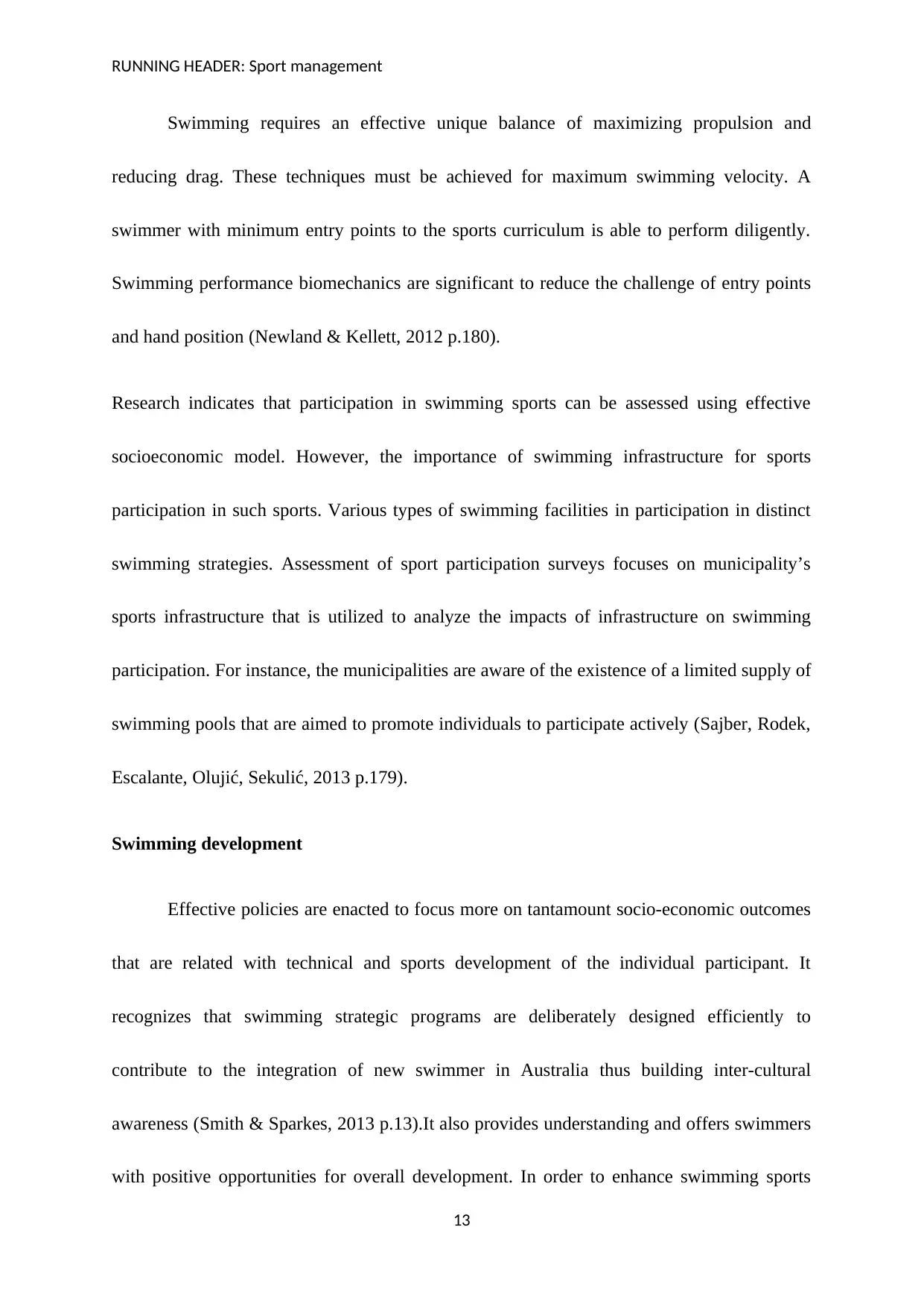
RUNNING HEADER: Sport management
Swimming requires an effective unique balance of maximizing propulsion and
reducing drag. These techniques must be achieved for maximum swimming velocity. A
swimmer with minimum entry points to the sports curriculum is able to perform diligently.
Swimming performance biomechanics are significant to reduce the challenge of entry points
and hand position (Newland & Kellett, 2012 p.180).
Research indicates that participation in swimming sports can be assessed using effective
socioeconomic model. However, the importance of swimming infrastructure for sports
participation in such sports. Various types of swimming facilities in participation in distinct
swimming strategies. Assessment of sport participation surveys focuses on municipality’s
sports infrastructure that is utilized to analyze the impacts of infrastructure on swimming
participation. For instance, the municipalities are aware of the existence of a limited supply of
swimming pools that are aimed to promote individuals to participate actively (Sajber, Rodek,
Escalante, Olujić, Sekulić, 2013 p.179).
Swimming development
Effective policies are enacted to focus more on tantamount socio-economic outcomes
that are related with technical and sports development of the individual participant. It
recognizes that swimming strategic programs are deliberately designed efficiently to
contribute to the integration of new swimmer in Australia thus building inter-cultural
awareness (Smith & Sparkes, 2013 p.13).It also provides understanding and offers swimmers
with positive opportunities for overall development. In order to enhance swimming sports
13
Swimming requires an effective unique balance of maximizing propulsion and
reducing drag. These techniques must be achieved for maximum swimming velocity. A
swimmer with minimum entry points to the sports curriculum is able to perform diligently.
Swimming performance biomechanics are significant to reduce the challenge of entry points
and hand position (Newland & Kellett, 2012 p.180).
Research indicates that participation in swimming sports can be assessed using effective
socioeconomic model. However, the importance of swimming infrastructure for sports
participation in such sports. Various types of swimming facilities in participation in distinct
swimming strategies. Assessment of sport participation surveys focuses on municipality’s
sports infrastructure that is utilized to analyze the impacts of infrastructure on swimming
participation. For instance, the municipalities are aware of the existence of a limited supply of
swimming pools that are aimed to promote individuals to participate actively (Sajber, Rodek,
Escalante, Olujić, Sekulić, 2013 p.179).
Swimming development
Effective policies are enacted to focus more on tantamount socio-economic outcomes
that are related with technical and sports development of the individual participant. It
recognizes that swimming strategic programs are deliberately designed efficiently to
contribute to the integration of new swimmer in Australia thus building inter-cultural
awareness (Smith & Sparkes, 2013 p.13).It also provides understanding and offers swimmers
with positive opportunities for overall development. In order to enhance swimming sports
13
Paraphrase This Document
Need a fresh take? Get an instant paraphrase of this document with our AI Paraphraser
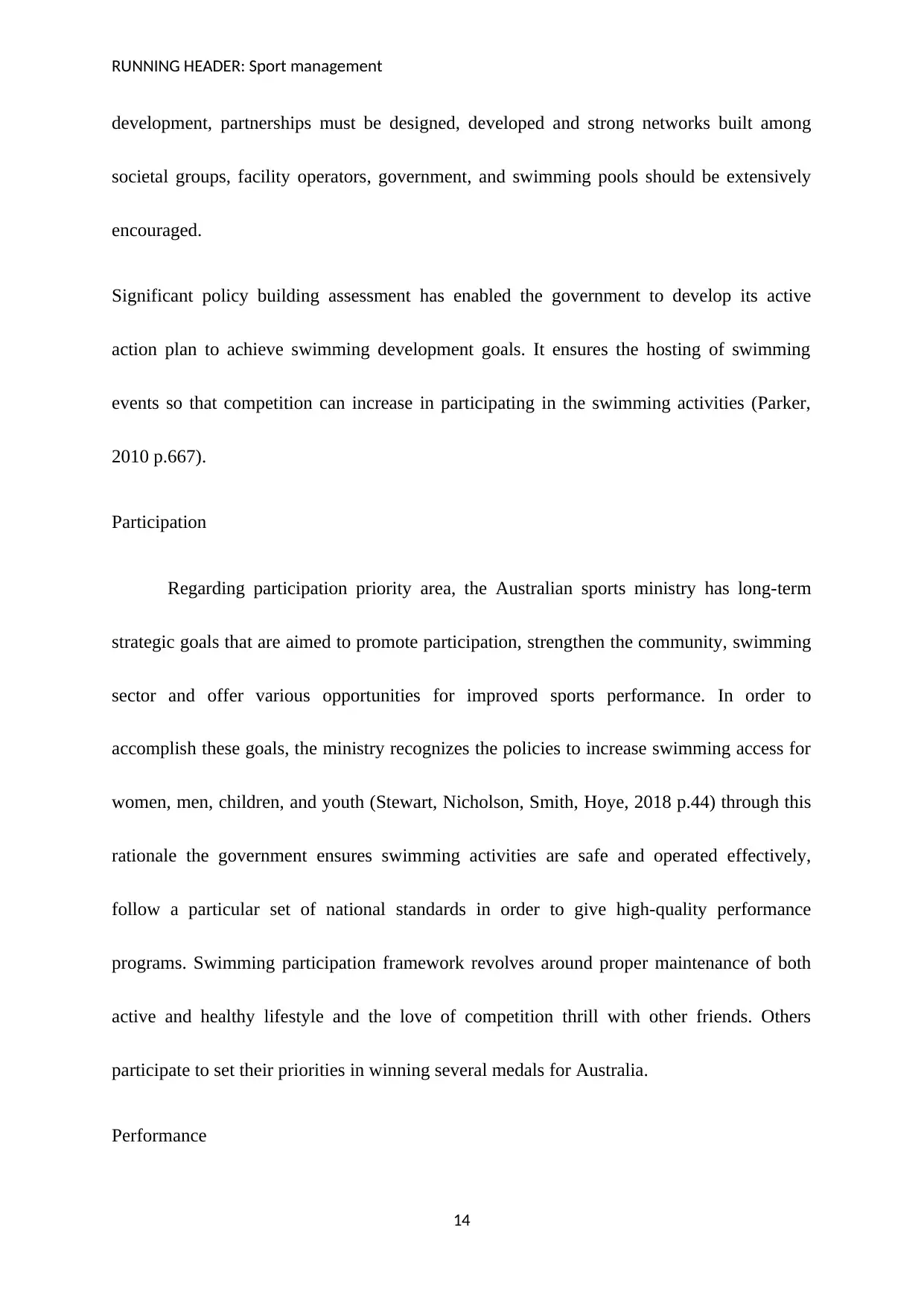
RUNNING HEADER: Sport management
development, partnerships must be designed, developed and strong networks built among
societal groups, facility operators, government, and swimming pools should be extensively
encouraged.
Significant policy building assessment has enabled the government to develop its active
action plan to achieve swimming development goals. It ensures the hosting of swimming
events so that competition can increase in participating in the swimming activities (Parker,
2010 p.667).
Participation
Regarding participation priority area, the Australian sports ministry has long-term
strategic goals that are aimed to promote participation, strengthen the community, swimming
sector and offer various opportunities for improved sports performance. In order to
accomplish these goals, the ministry recognizes the policies to increase swimming access for
women, men, children, and youth (Stewart, Nicholson, Smith, Hoye, 2018 p.44) through this
rationale the government ensures swimming activities are safe and operated effectively,
follow a particular set of national standards in order to give high-quality performance
programs. Swimming participation framework revolves around proper maintenance of both
active and healthy lifestyle and the love of competition thrill with other friends. Others
participate to set their priorities in winning several medals for Australia.
Performance
14
development, partnerships must be designed, developed and strong networks built among
societal groups, facility operators, government, and swimming pools should be extensively
encouraged.
Significant policy building assessment has enabled the government to develop its active
action plan to achieve swimming development goals. It ensures the hosting of swimming
events so that competition can increase in participating in the swimming activities (Parker,
2010 p.667).
Participation
Regarding participation priority area, the Australian sports ministry has long-term
strategic goals that are aimed to promote participation, strengthen the community, swimming
sector and offer various opportunities for improved sports performance. In order to
accomplish these goals, the ministry recognizes the policies to increase swimming access for
women, men, children, and youth (Stewart, Nicholson, Smith, Hoye, 2018 p.44) through this
rationale the government ensures swimming activities are safe and operated effectively,
follow a particular set of national standards in order to give high-quality performance
programs. Swimming participation framework revolves around proper maintenance of both
active and healthy lifestyle and the love of competition thrill with other friends. Others
participate to set their priorities in winning several medals for Australia.
Performance
14
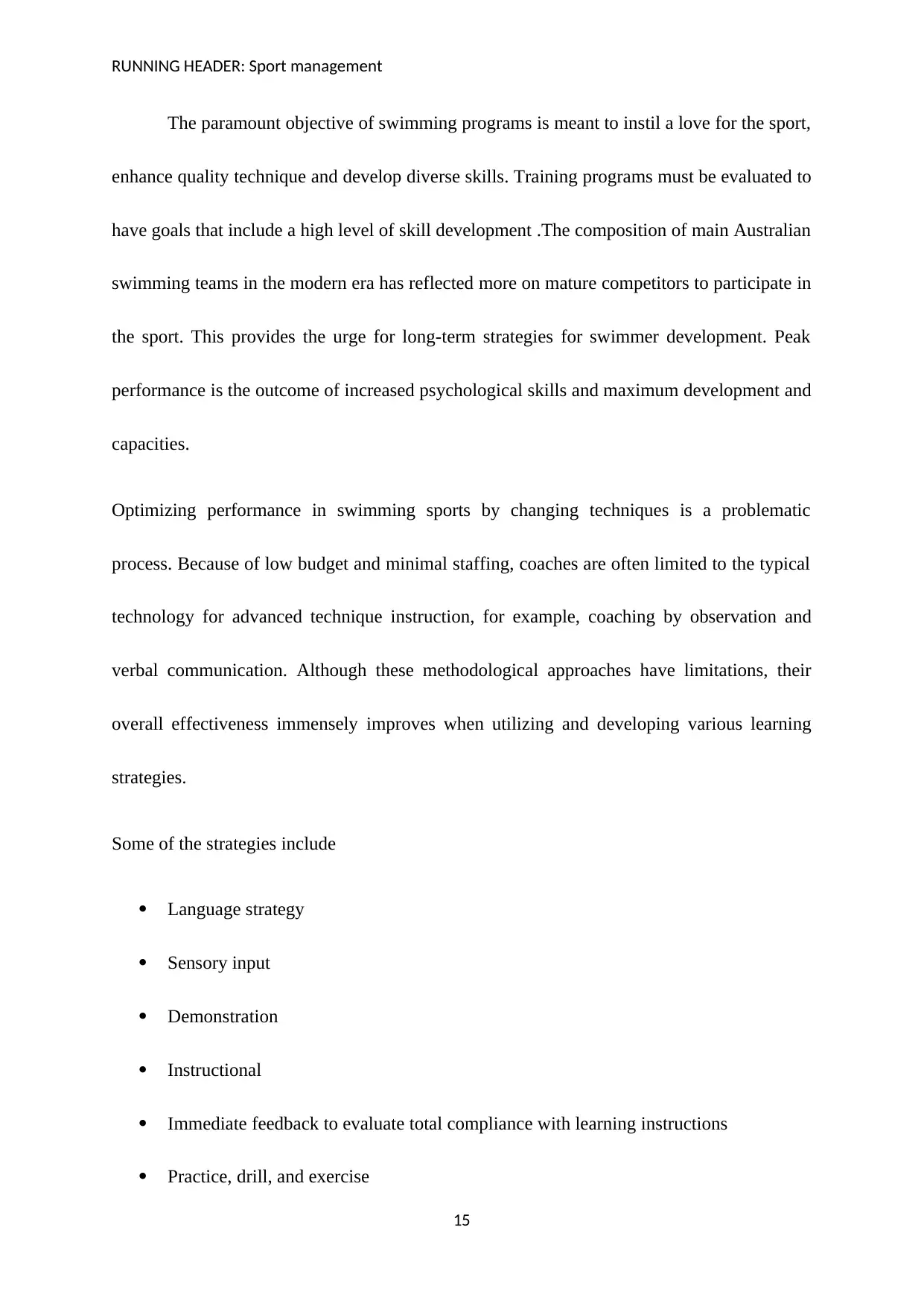
RUNNING HEADER: Sport management
The paramount objective of swimming programs is meant to instil a love for the sport,
enhance quality technique and develop diverse skills. Training programs must be evaluated to
have goals that include a high level of skill development .The composition of main Australian
swimming teams in the modern era has reflected more on mature competitors to participate in
the sport. This provides the urge for long-term strategies for swimmer development. Peak
performance is the outcome of increased psychological skills and maximum development and
capacities.
Optimizing performance in swimming sports by changing techniques is a problematic
process. Because of low budget and minimal staffing, coaches are often limited to the typical
technology for advanced technique instruction, for example, coaching by observation and
verbal communication. Although these methodological approaches have limitations, their
overall effectiveness immensely improves when utilizing and developing various learning
strategies.
Some of the strategies include
Language strategy
Sensory input
Demonstration
Instructional
Immediate feedback to evaluate total compliance with learning instructions
Practice, drill, and exercise
15
The paramount objective of swimming programs is meant to instil a love for the sport,
enhance quality technique and develop diverse skills. Training programs must be evaluated to
have goals that include a high level of skill development .The composition of main Australian
swimming teams in the modern era has reflected more on mature competitors to participate in
the sport. This provides the urge for long-term strategies for swimmer development. Peak
performance is the outcome of increased psychological skills and maximum development and
capacities.
Optimizing performance in swimming sports by changing techniques is a problematic
process. Because of low budget and minimal staffing, coaches are often limited to the typical
technology for advanced technique instruction, for example, coaching by observation and
verbal communication. Although these methodological approaches have limitations, their
overall effectiveness immensely improves when utilizing and developing various learning
strategies.
Some of the strategies include
Language strategy
Sensory input
Demonstration
Instructional
Immediate feedback to evaluate total compliance with learning instructions
Practice, drill, and exercise
15
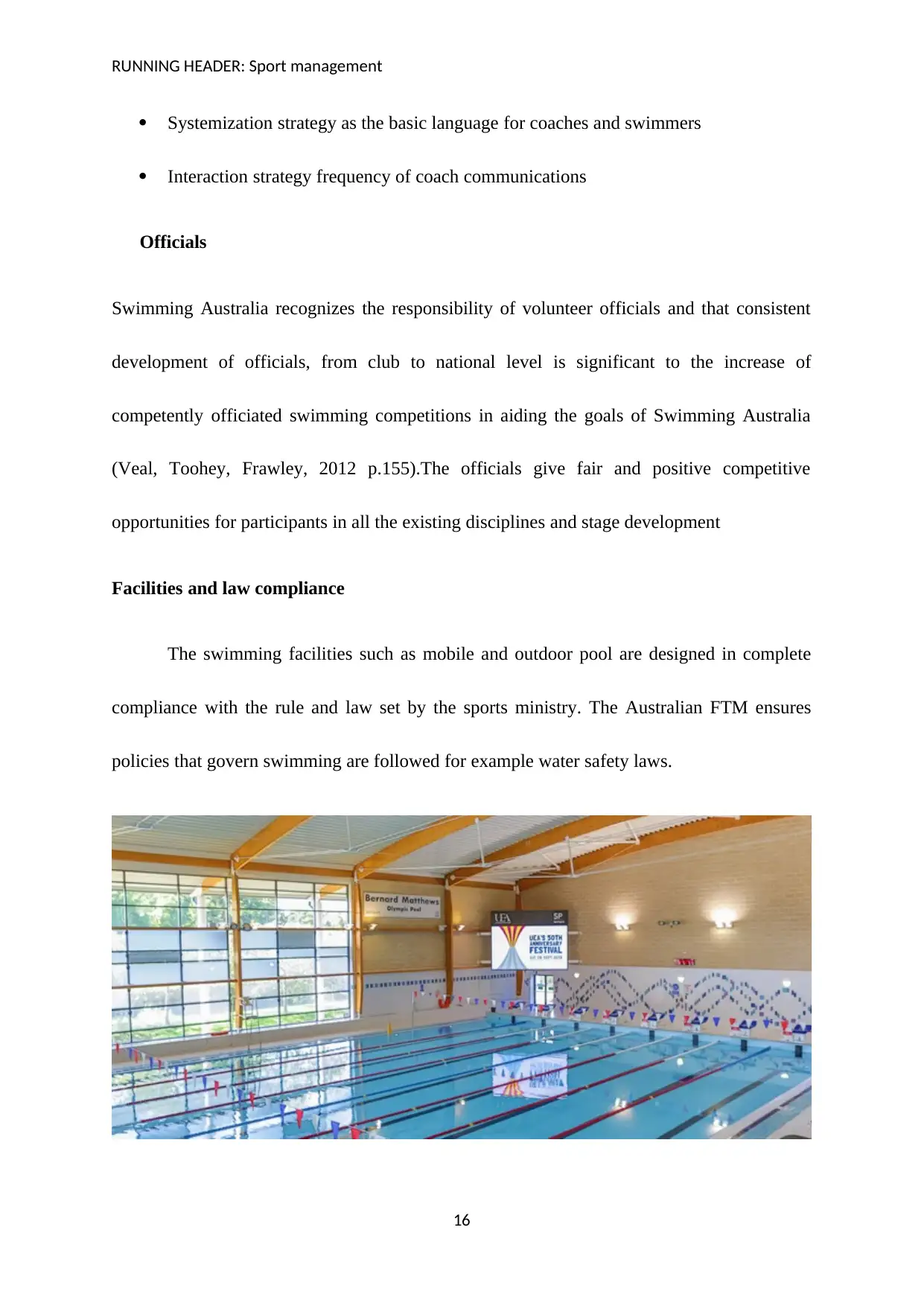
RUNNING HEADER: Sport management
Systemization strategy as the basic language for coaches and swimmers
Interaction strategy frequency of coach communications
Officials
Swimming Australia recognizes the responsibility of volunteer officials and that consistent
development of officials, from club to national level is significant to the increase of
competently officiated swimming competitions in aiding the goals of Swimming Australia
(Veal, Toohey, Frawley, 2012 p.155).The officials give fair and positive competitive
opportunities for participants in all the existing disciplines and stage development
Facilities and law compliance
The swimming facilities such as mobile and outdoor pool are designed in complete
compliance with the rule and law set by the sports ministry. The Australian FTM ensures
policies that govern swimming are followed for example water safety laws.
16
Systemization strategy as the basic language for coaches and swimmers
Interaction strategy frequency of coach communications
Officials
Swimming Australia recognizes the responsibility of volunteer officials and that consistent
development of officials, from club to national level is significant to the increase of
competently officiated swimming competitions in aiding the goals of Swimming Australia
(Veal, Toohey, Frawley, 2012 p.155).The officials give fair and positive competitive
opportunities for participants in all the existing disciplines and stage development
Facilities and law compliance
The swimming facilities such as mobile and outdoor pool are designed in complete
compliance with the rule and law set by the sports ministry. The Australian FTM ensures
policies that govern swimming are followed for example water safety laws.
16
Secure Best Marks with AI Grader
Need help grading? Try our AI Grader for instant feedback on your assignments.
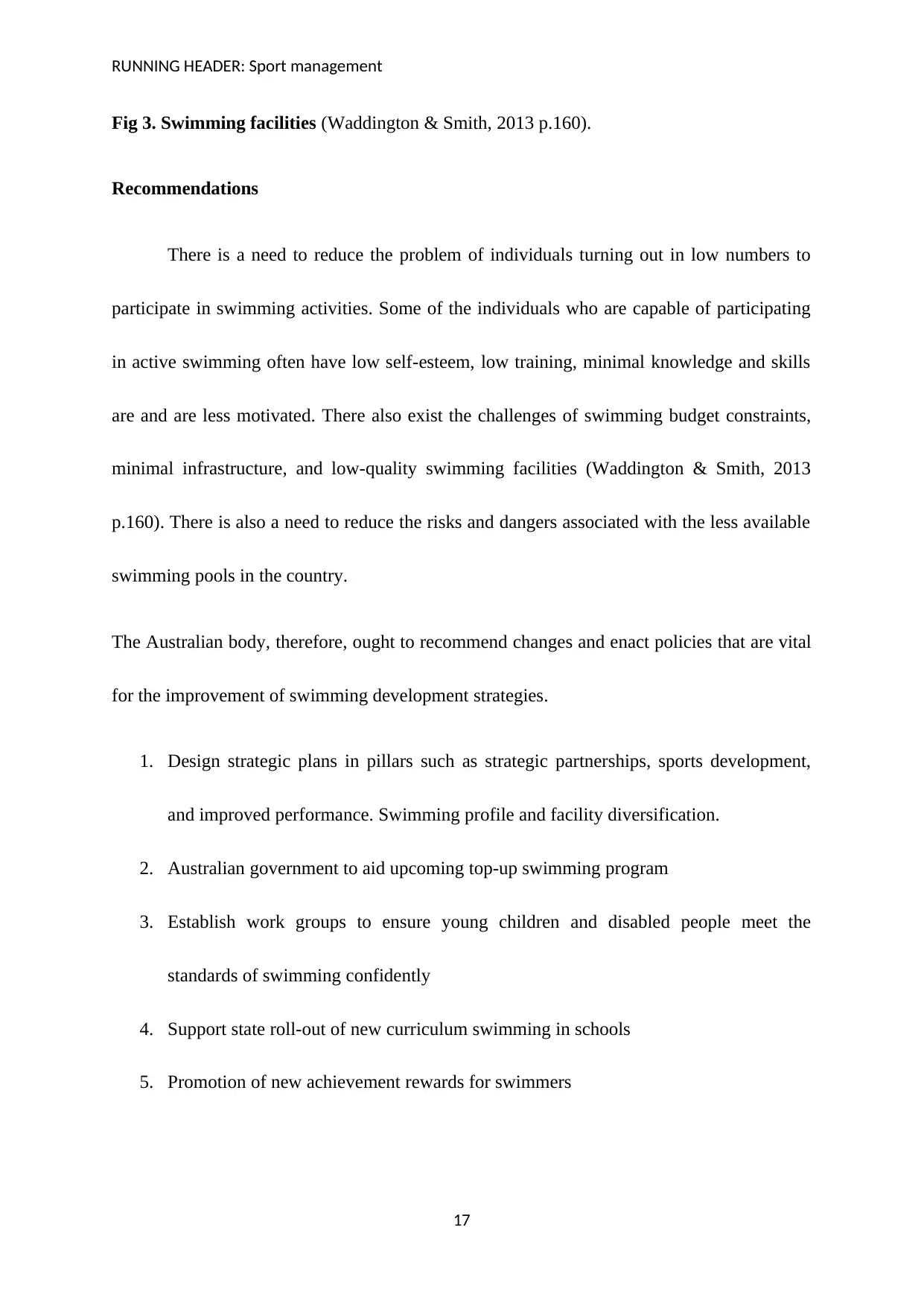
RUNNING HEADER: Sport management
Fig 3. Swimming facilities (Waddington & Smith, 2013 p.160).
Recommendations
There is a need to reduce the problem of individuals turning out in low numbers to
participate in swimming activities. Some of the individuals who are capable of participating
in active swimming often have low self-esteem, low training, minimal knowledge and skills
are and are less motivated. There also exist the challenges of swimming budget constraints,
minimal infrastructure, and low-quality swimming facilities (Waddington & Smith, 2013
p.160). There is also a need to reduce the risks and dangers associated with the less available
swimming pools in the country.
The Australian body, therefore, ought to recommend changes and enact policies that are vital
for the improvement of swimming development strategies.
1. Design strategic plans in pillars such as strategic partnerships, sports development,
and improved performance. Swimming profile and facility diversification.
2. Australian government to aid upcoming top-up swimming program
3. Establish work groups to ensure young children and disabled people meet the
standards of swimming confidently
4. Support state roll-out of new curriculum swimming in schools
5. Promotion of new achievement rewards for swimmers
17
Fig 3. Swimming facilities (Waddington & Smith, 2013 p.160).
Recommendations
There is a need to reduce the problem of individuals turning out in low numbers to
participate in swimming activities. Some of the individuals who are capable of participating
in active swimming often have low self-esteem, low training, minimal knowledge and skills
are and are less motivated. There also exist the challenges of swimming budget constraints,
minimal infrastructure, and low-quality swimming facilities (Waddington & Smith, 2013
p.160). There is also a need to reduce the risks and dangers associated with the less available
swimming pools in the country.
The Australian body, therefore, ought to recommend changes and enact policies that are vital
for the improvement of swimming development strategies.
1. Design strategic plans in pillars such as strategic partnerships, sports development,
and improved performance. Swimming profile and facility diversification.
2. Australian government to aid upcoming top-up swimming program
3. Establish work groups to ensure young children and disabled people meet the
standards of swimming confidently
4. Support state roll-out of new curriculum swimming in schools
5. Promotion of new achievement rewards for swimmers
17
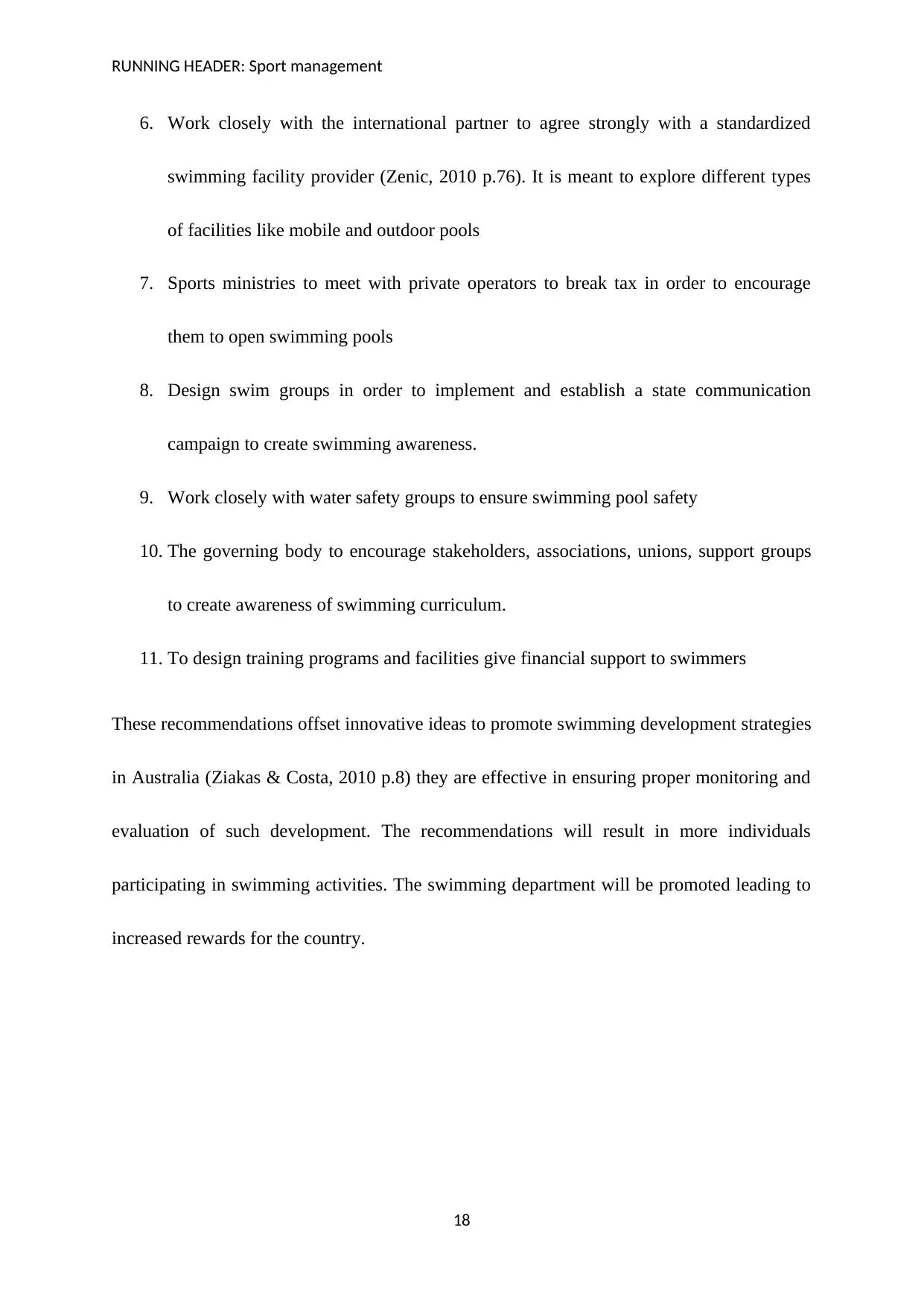
RUNNING HEADER: Sport management
6. Work closely with the international partner to agree strongly with a standardized
swimming facility provider (Zenic, 2010 p.76). It is meant to explore different types
of facilities like mobile and outdoor pools
7. Sports ministries to meet with private operators to break tax in order to encourage
them to open swimming pools
8. Design swim groups in order to implement and establish a state communication
campaign to create swimming awareness.
9. Work closely with water safety groups to ensure swimming pool safety
10. The governing body to encourage stakeholders, associations, unions, support groups
to create awareness of swimming curriculum.
11. To design training programs and facilities give financial support to swimmers
These recommendations offset innovative ideas to promote swimming development strategies
in Australia (Ziakas & Costa, 2010 p.8) they are effective in ensuring proper monitoring and
evaluation of such development. The recommendations will result in more individuals
participating in swimming activities. The swimming department will be promoted leading to
increased rewards for the country.
18
6. Work closely with the international partner to agree strongly with a standardized
swimming facility provider (Zenic, 2010 p.76). It is meant to explore different types
of facilities like mobile and outdoor pools
7. Sports ministries to meet with private operators to break tax in order to encourage
them to open swimming pools
8. Design swim groups in order to implement and establish a state communication
campaign to create swimming awareness.
9. Work closely with water safety groups to ensure swimming pool safety
10. The governing body to encourage stakeholders, associations, unions, support groups
to create awareness of swimming curriculum.
11. To design training programs and facilities give financial support to swimmers
These recommendations offset innovative ideas to promote swimming development strategies
in Australia (Ziakas & Costa, 2010 p.8) they are effective in ensuring proper monitoring and
evaluation of such development. The recommendations will result in more individuals
participating in swimming activities. The swimming department will be promoted leading to
increased rewards for the country.
18
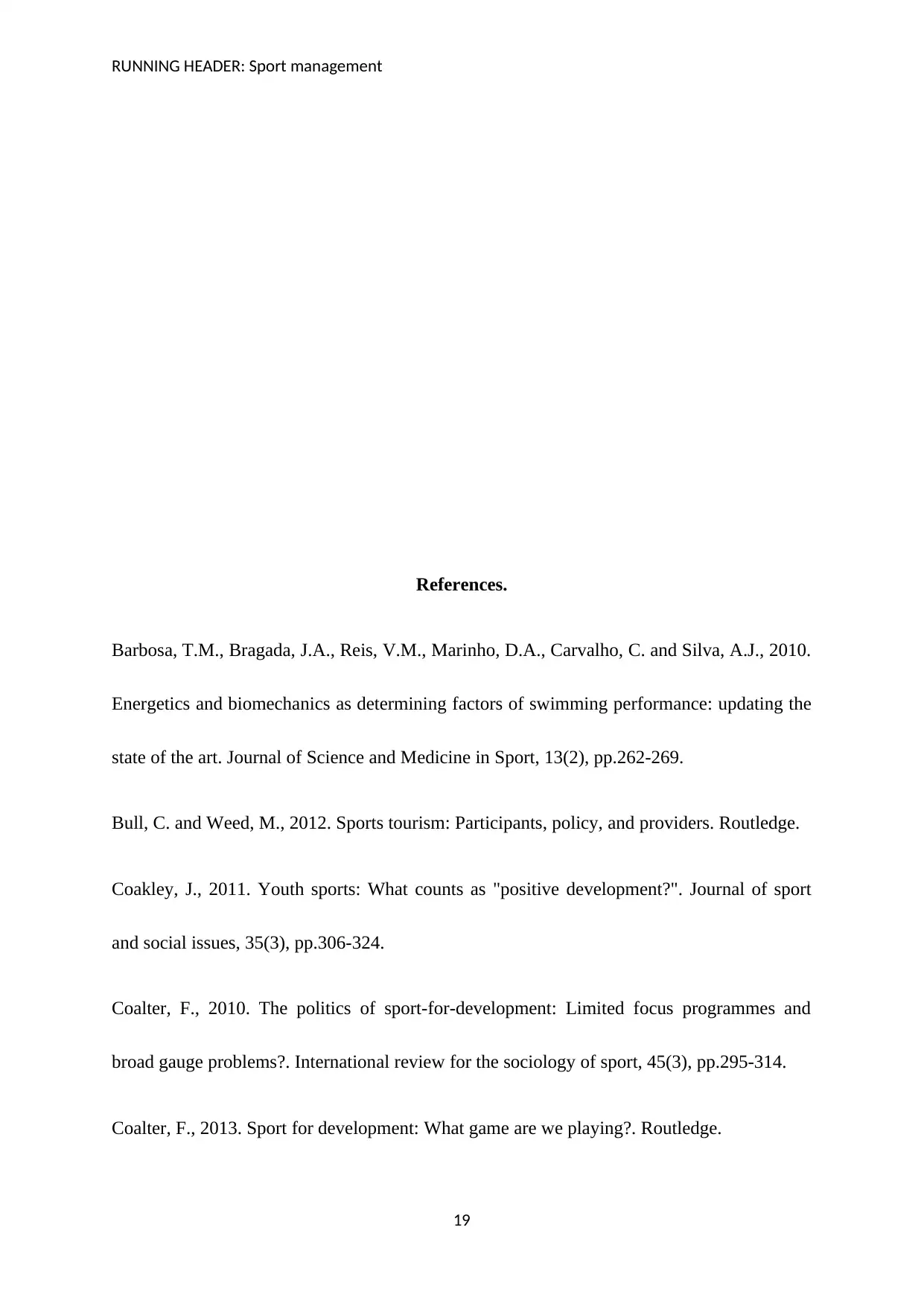
RUNNING HEADER: Sport management
References.
Barbosa, T.M., Bragada, J.A., Reis, V.M., Marinho, D.A., Carvalho, C. and Silva, A.J., 2010.
Energetics and biomechanics as determining factors of swimming performance: updating the
state of the art. Journal of Science and Medicine in Sport, 13(2), pp.262-269.
Bull, C. and Weed, M., 2012. Sports tourism: Participants, policy, and providers. Routledge.
Coakley, J., 2011. Youth sports: What counts as "positive development?". Journal of sport
and social issues, 35(3), pp.306-324.
Coalter, F., 2010. The politics of sport-for-development: Limited focus programmes and
broad gauge problems?. International review for the sociology of sport, 45(3), pp.295-314.
Coalter, F., 2013. Sport for development: What game are we playing?. Routledge.
19
References.
Barbosa, T.M., Bragada, J.A., Reis, V.M., Marinho, D.A., Carvalho, C. and Silva, A.J., 2010.
Energetics and biomechanics as determining factors of swimming performance: updating the
state of the art. Journal of Science and Medicine in Sport, 13(2), pp.262-269.
Bull, C. and Weed, M., 2012. Sports tourism: Participants, policy, and providers. Routledge.
Coakley, J., 2011. Youth sports: What counts as "positive development?". Journal of sport
and social issues, 35(3), pp.306-324.
Coalter, F., 2010. The politics of sport-for-development: Limited focus programmes and
broad gauge problems?. International review for the sociology of sport, 45(3), pp.295-314.
Coalter, F., 2013. Sport for development: What game are we playing?. Routledge.
19
Paraphrase This Document
Need a fresh take? Get an instant paraphrase of this document with our AI Paraphraser
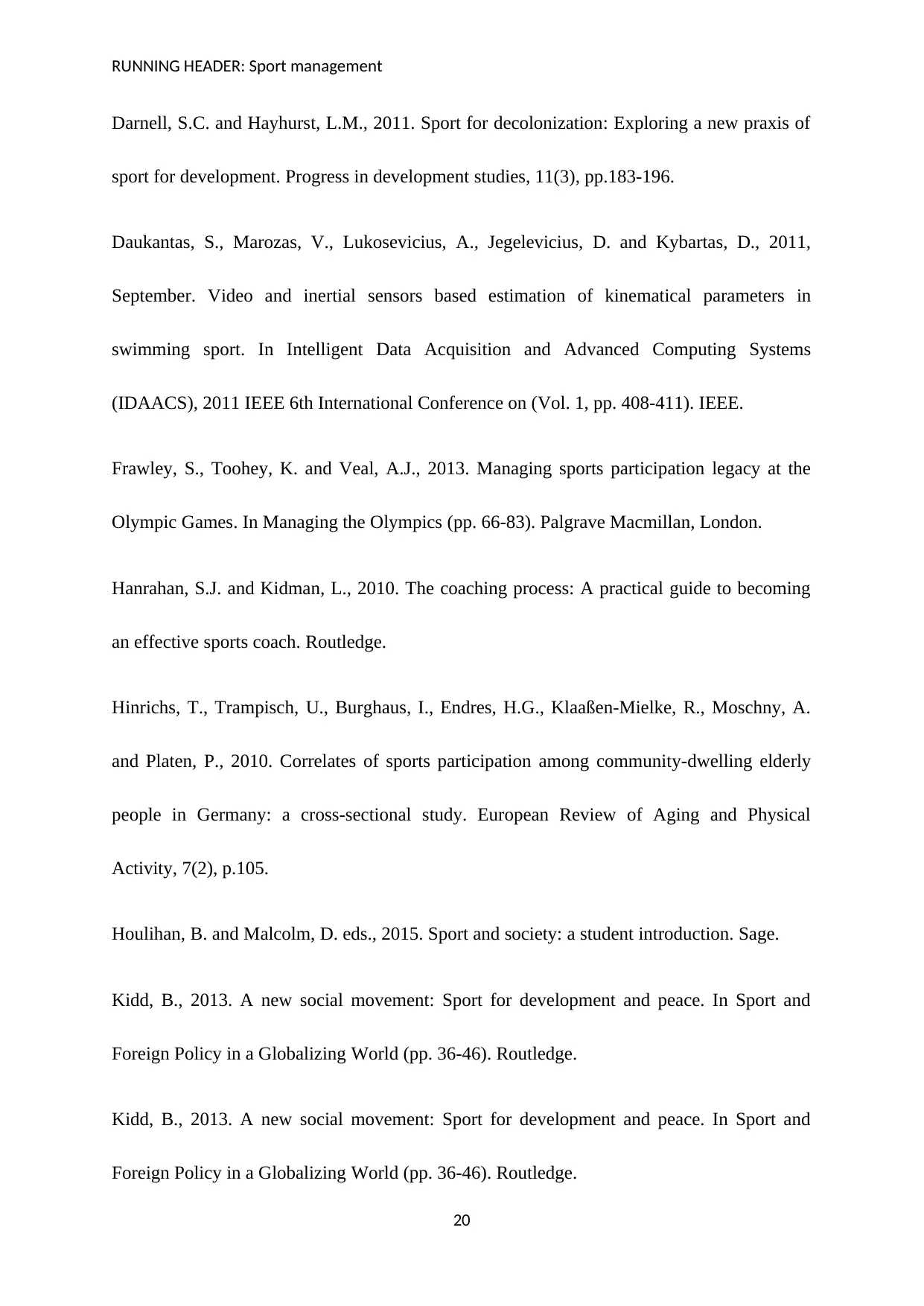
RUNNING HEADER: Sport management
Darnell, S.C. and Hayhurst, L.M., 2011. Sport for decolonization: Exploring a new praxis of
sport for development. Progress in development studies, 11(3), pp.183-196.
Daukantas, S., Marozas, V., Lukosevicius, A., Jegelevicius, D. and Kybartas, D., 2011,
September. Video and inertial sensors based estimation of kinematical parameters in
swimming sport. In Intelligent Data Acquisition and Advanced Computing Systems
(IDAACS), 2011 IEEE 6th International Conference on (Vol. 1, pp. 408-411). IEEE.
Frawley, S., Toohey, K. and Veal, A.J., 2013. Managing sports participation legacy at the
Olympic Games. In Managing the Olympics (pp. 66-83). Palgrave Macmillan, London.
Hanrahan, S.J. and Kidman, L., 2010. The coaching process: A practical guide to becoming
an effective sports coach. Routledge.
Hinrichs, T., Trampisch, U., Burghaus, I., Endres, H.G., Klaaßen-Mielke, R., Moschny, A.
and Platen, P., 2010. Correlates of sports participation among community-dwelling elderly
people in Germany: a cross-sectional study. European Review of Aging and Physical
Activity, 7(2), p.105.
Houlihan, B. and Malcolm, D. eds., 2015. Sport and society: a student introduction. Sage.
Kidd, B., 2013. A new social movement: Sport for development and peace. In Sport and
Foreign Policy in a Globalizing World (pp. 36-46). Routledge.
Kidd, B., 2013. A new social movement: Sport for development and peace. In Sport and
Foreign Policy in a Globalizing World (pp. 36-46). Routledge.
20
Darnell, S.C. and Hayhurst, L.M., 2011. Sport for decolonization: Exploring a new praxis of
sport for development. Progress in development studies, 11(3), pp.183-196.
Daukantas, S., Marozas, V., Lukosevicius, A., Jegelevicius, D. and Kybartas, D., 2011,
September. Video and inertial sensors based estimation of kinematical parameters in
swimming sport. In Intelligent Data Acquisition and Advanced Computing Systems
(IDAACS), 2011 IEEE 6th International Conference on (Vol. 1, pp. 408-411). IEEE.
Frawley, S., Toohey, K. and Veal, A.J., 2013. Managing sports participation legacy at the
Olympic Games. In Managing the Olympics (pp. 66-83). Palgrave Macmillan, London.
Hanrahan, S.J. and Kidman, L., 2010. The coaching process: A practical guide to becoming
an effective sports coach. Routledge.
Hinrichs, T., Trampisch, U., Burghaus, I., Endres, H.G., Klaaßen-Mielke, R., Moschny, A.
and Platen, P., 2010. Correlates of sports participation among community-dwelling elderly
people in Germany: a cross-sectional study. European Review of Aging and Physical
Activity, 7(2), p.105.
Houlihan, B. and Malcolm, D. eds., 2015. Sport and society: a student introduction. Sage.
Kidd, B., 2013. A new social movement: Sport for development and peace. In Sport and
Foreign Policy in a Globalizing World (pp. 36-46). Routledge.
Kidd, B., 2013. A new social movement: Sport for development and peace. In Sport and
Foreign Policy in a Globalizing World (pp. 36-46). Routledge.
20
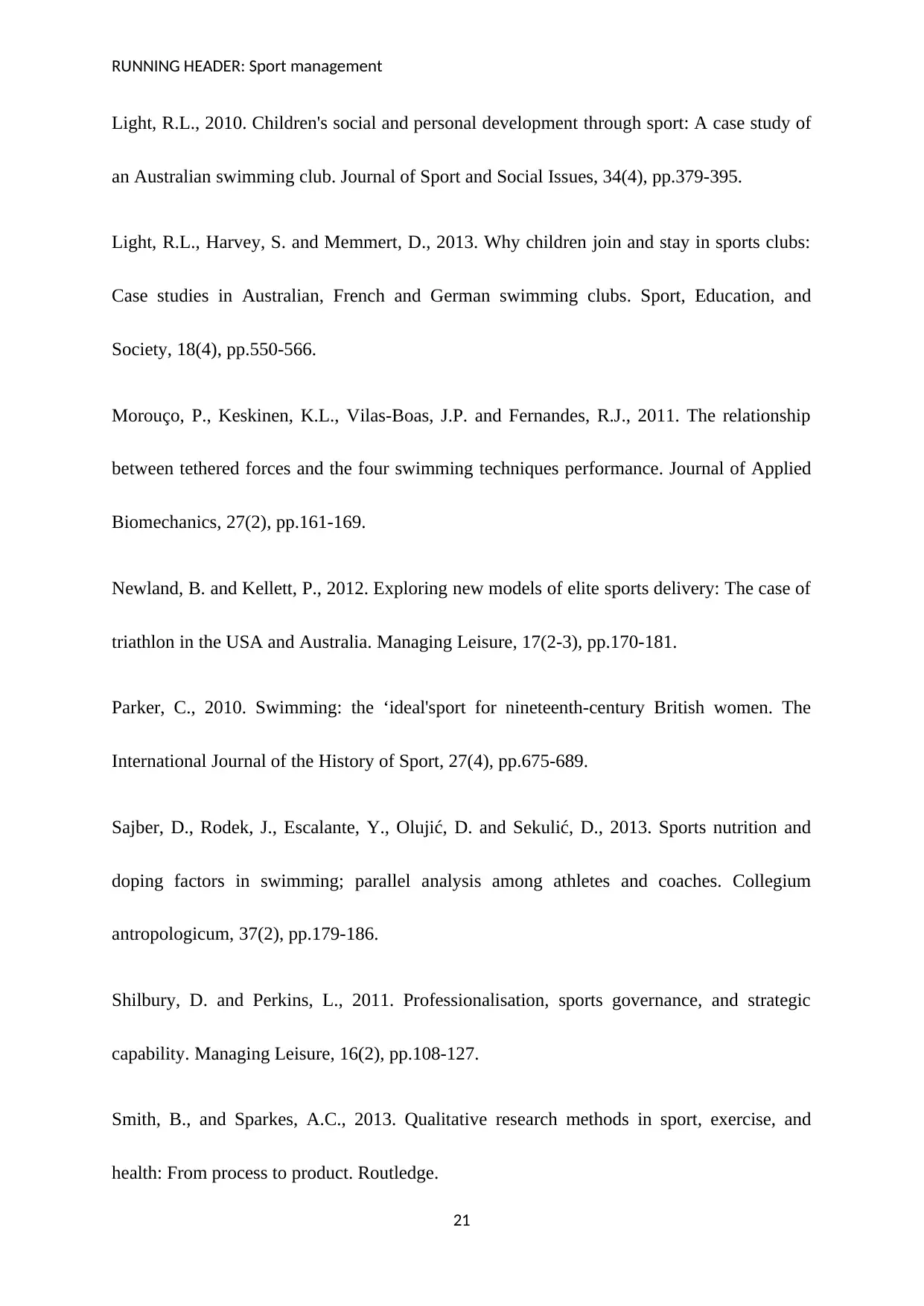
RUNNING HEADER: Sport management
Light, R.L., 2010. Children's social and personal development through sport: A case study of
an Australian swimming club. Journal of Sport and Social Issues, 34(4), pp.379-395.
Light, R.L., Harvey, S. and Memmert, D., 2013. Why children join and stay in sports clubs:
Case studies in Australian, French and German swimming clubs. Sport, Education, and
Society, 18(4), pp.550-566.
Morouço, P., Keskinen, K.L., Vilas-Boas, J.P. and Fernandes, R.J., 2011. The relationship
between tethered forces and the four swimming techniques performance. Journal of Applied
Biomechanics, 27(2), pp.161-169.
Newland, B. and Kellett, P., 2012. Exploring new models of elite sports delivery: The case of
triathlon in the USA and Australia. Managing Leisure, 17(2-3), pp.170-181.
Parker, C., 2010. Swimming: the ‘ideal'sport for nineteenth-century British women. The
International Journal of the History of Sport, 27(4), pp.675-689.
Sajber, D., Rodek, J., Escalante, Y., Olujić, D. and Sekulić, D., 2013. Sports nutrition and
doping factors in swimming; parallel analysis among athletes and coaches. Collegium
antropologicum, 37(2), pp.179-186.
Shilbury, D. and Perkins, L., 2011. Professionalisation, sports governance, and strategic
capability. Managing Leisure, 16(2), pp.108-127.
Smith, B., and Sparkes, A.C., 2013. Qualitative research methods in sport, exercise, and
health: From process to product. Routledge.
21
Light, R.L., 2010. Children's social and personal development through sport: A case study of
an Australian swimming club. Journal of Sport and Social Issues, 34(4), pp.379-395.
Light, R.L., Harvey, S. and Memmert, D., 2013. Why children join and stay in sports clubs:
Case studies in Australian, French and German swimming clubs. Sport, Education, and
Society, 18(4), pp.550-566.
Morouço, P., Keskinen, K.L., Vilas-Boas, J.P. and Fernandes, R.J., 2011. The relationship
between tethered forces and the four swimming techniques performance. Journal of Applied
Biomechanics, 27(2), pp.161-169.
Newland, B. and Kellett, P., 2012. Exploring new models of elite sports delivery: The case of
triathlon in the USA and Australia. Managing Leisure, 17(2-3), pp.170-181.
Parker, C., 2010. Swimming: the ‘ideal'sport for nineteenth-century British women. The
International Journal of the History of Sport, 27(4), pp.675-689.
Sajber, D., Rodek, J., Escalante, Y., Olujić, D. and Sekulić, D., 2013. Sports nutrition and
doping factors in swimming; parallel analysis among athletes and coaches. Collegium
antropologicum, 37(2), pp.179-186.
Shilbury, D. and Perkins, L., 2011. Professionalisation, sports governance, and strategic
capability. Managing Leisure, 16(2), pp.108-127.
Smith, B., and Sparkes, A.C., 2013. Qualitative research methods in sport, exercise, and
health: From process to product. Routledge.
21
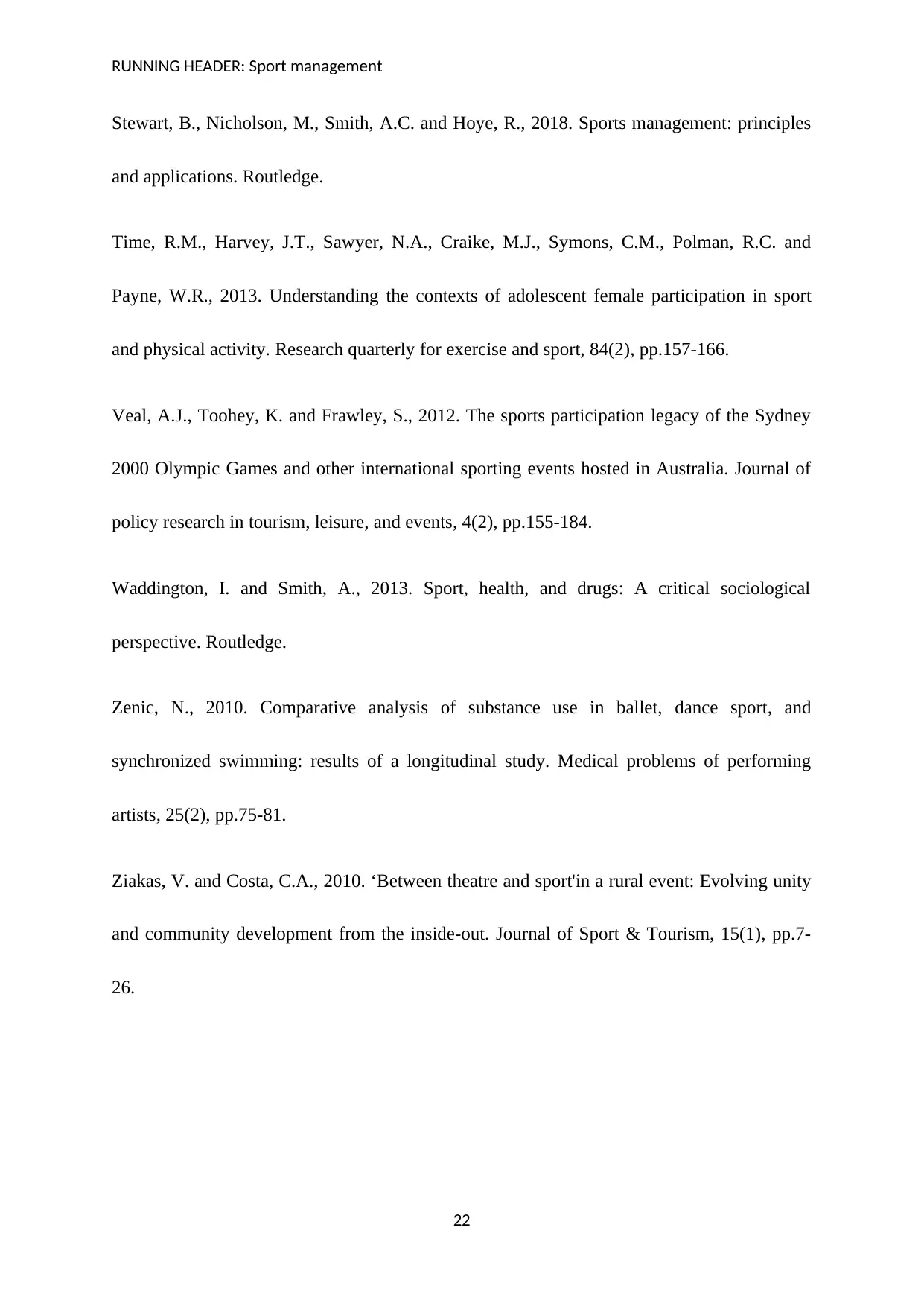
RUNNING HEADER: Sport management
Stewart, B., Nicholson, M., Smith, A.C. and Hoye, R., 2018. Sports management: principles
and applications. Routledge.
Time, R.M., Harvey, J.T., Sawyer, N.A., Craike, M.J., Symons, C.M., Polman, R.C. and
Payne, W.R., 2013. Understanding the contexts of adolescent female participation in sport
and physical activity. Research quarterly for exercise and sport, 84(2), pp.157-166.
Veal, A.J., Toohey, K. and Frawley, S., 2012. The sports participation legacy of the Sydney
2000 Olympic Games and other international sporting events hosted in Australia. Journal of
policy research in tourism, leisure, and events, 4(2), pp.155-184.
Waddington, I. and Smith, A., 2013. Sport, health, and drugs: A critical sociological
perspective. Routledge.
Zenic, N., 2010. Comparative analysis of substance use in ballet, dance sport, and
synchronized swimming: results of a longitudinal study. Medical problems of performing
artists, 25(2), pp.75-81.
Ziakas, V. and Costa, C.A., 2010. ‘Between theatre and sport'in a rural event: Evolving unity
and community development from the inside-out. Journal of Sport & Tourism, 15(1), pp.7-
26.
22
Stewart, B., Nicholson, M., Smith, A.C. and Hoye, R., 2018. Sports management: principles
and applications. Routledge.
Time, R.M., Harvey, J.T., Sawyer, N.A., Craike, M.J., Symons, C.M., Polman, R.C. and
Payne, W.R., 2013. Understanding the contexts of adolescent female participation in sport
and physical activity. Research quarterly for exercise and sport, 84(2), pp.157-166.
Veal, A.J., Toohey, K. and Frawley, S., 2012. The sports participation legacy of the Sydney
2000 Olympic Games and other international sporting events hosted in Australia. Journal of
policy research in tourism, leisure, and events, 4(2), pp.155-184.
Waddington, I. and Smith, A., 2013. Sport, health, and drugs: A critical sociological
perspective. Routledge.
Zenic, N., 2010. Comparative analysis of substance use in ballet, dance sport, and
synchronized swimming: results of a longitudinal study. Medical problems of performing
artists, 25(2), pp.75-81.
Ziakas, V. and Costa, C.A., 2010. ‘Between theatre and sport'in a rural event: Evolving unity
and community development from the inside-out. Journal of Sport & Tourism, 15(1), pp.7-
26.
22
Secure Best Marks with AI Grader
Need help grading? Try our AI Grader for instant feedback on your assignments.
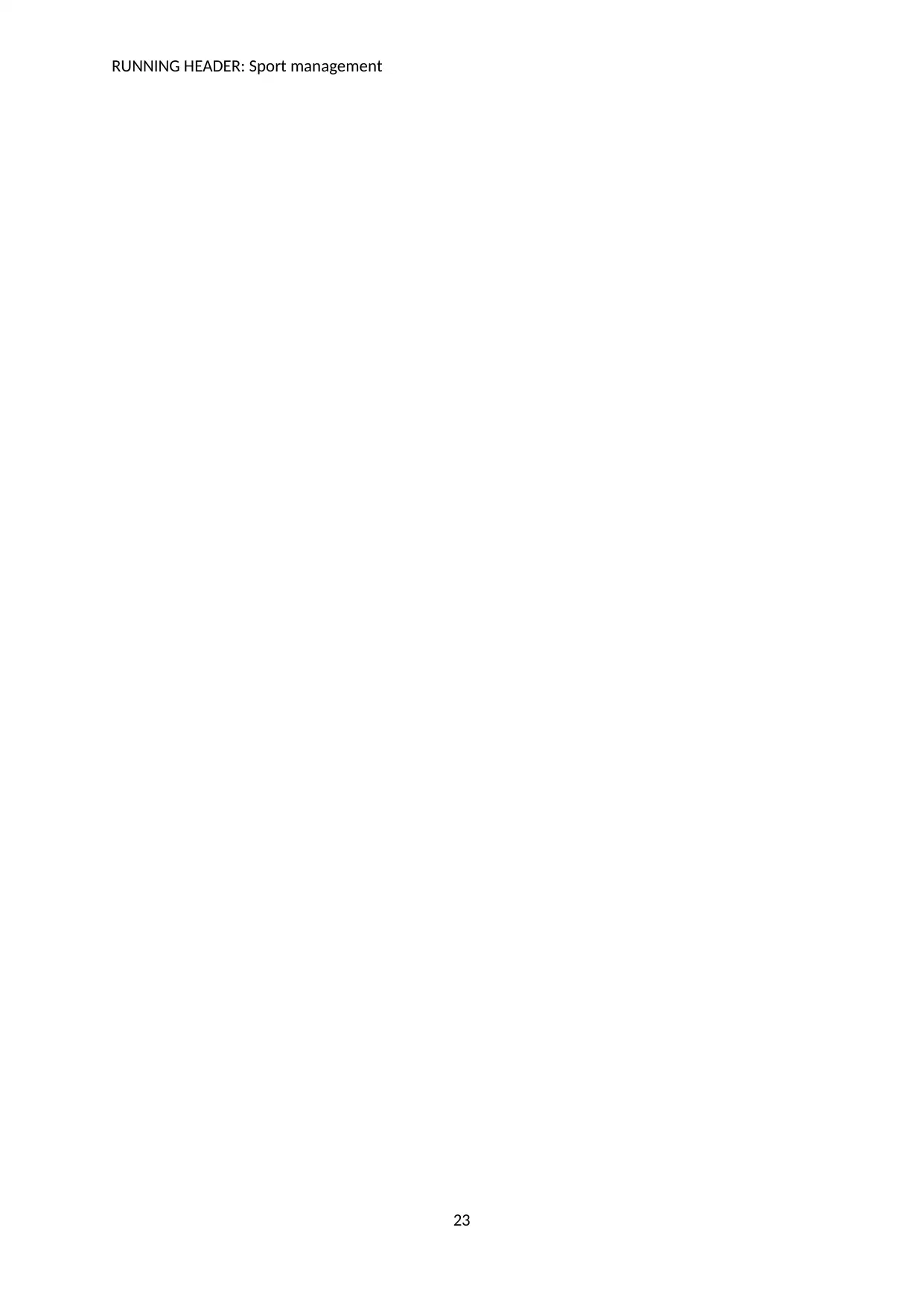
RUNNING HEADER: Sport management
23
23
1 out of 23
Your All-in-One AI-Powered Toolkit for Academic Success.
+13062052269
info@desklib.com
Available 24*7 on WhatsApp / Email
![[object Object]](/_next/static/media/star-bottom.7253800d.svg)
Unlock your academic potential
© 2024 | Zucol Services PVT LTD | All rights reserved.